The Alexander Sarcophagus: Alexander conquered the known world, but who was this monument for and what does it symbolize?
Read Now >Chapter 17
Empire and Art in the Hellenistic world (c. 350–31 B.C.E.)
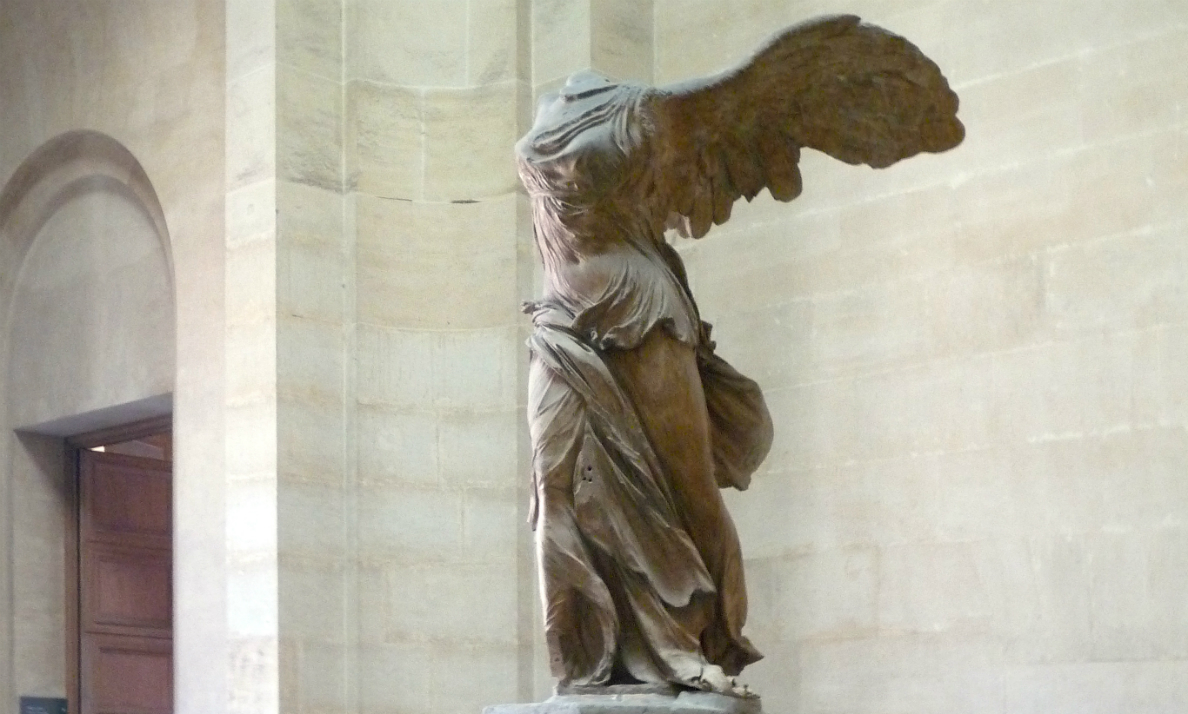
Nike (Winged Victory) of Samothrace, Lartos marble (ship) and Parian marble (figure), c. 190 B.C.E. 3.28 m high, Hellenistic Period (Musée du Louvre, Paris)
In contrast to the earlier Classical period, art of the Hellenistic period (c. 323–31 B.C.E.) has not been universally revered in modern art history. Beginning with Johann Joachim Winckelmann in the eighteenth century and continuing into the twentieth century, scholars referred to the period as one of decline and decadence. Yet, this approximately three-hundred-year period was one of artistic vibrance and immense cultural influence. In the twenty-first century, this period is finally beginning to see a revision in its reputation. Art historians and archaeologists are now recognizing the diversity and significance of the art produced in an era defined by conquest and war, cultural imperialism, dramatic and expensive art and architecture, and the transmission of art and ideas across large areas.
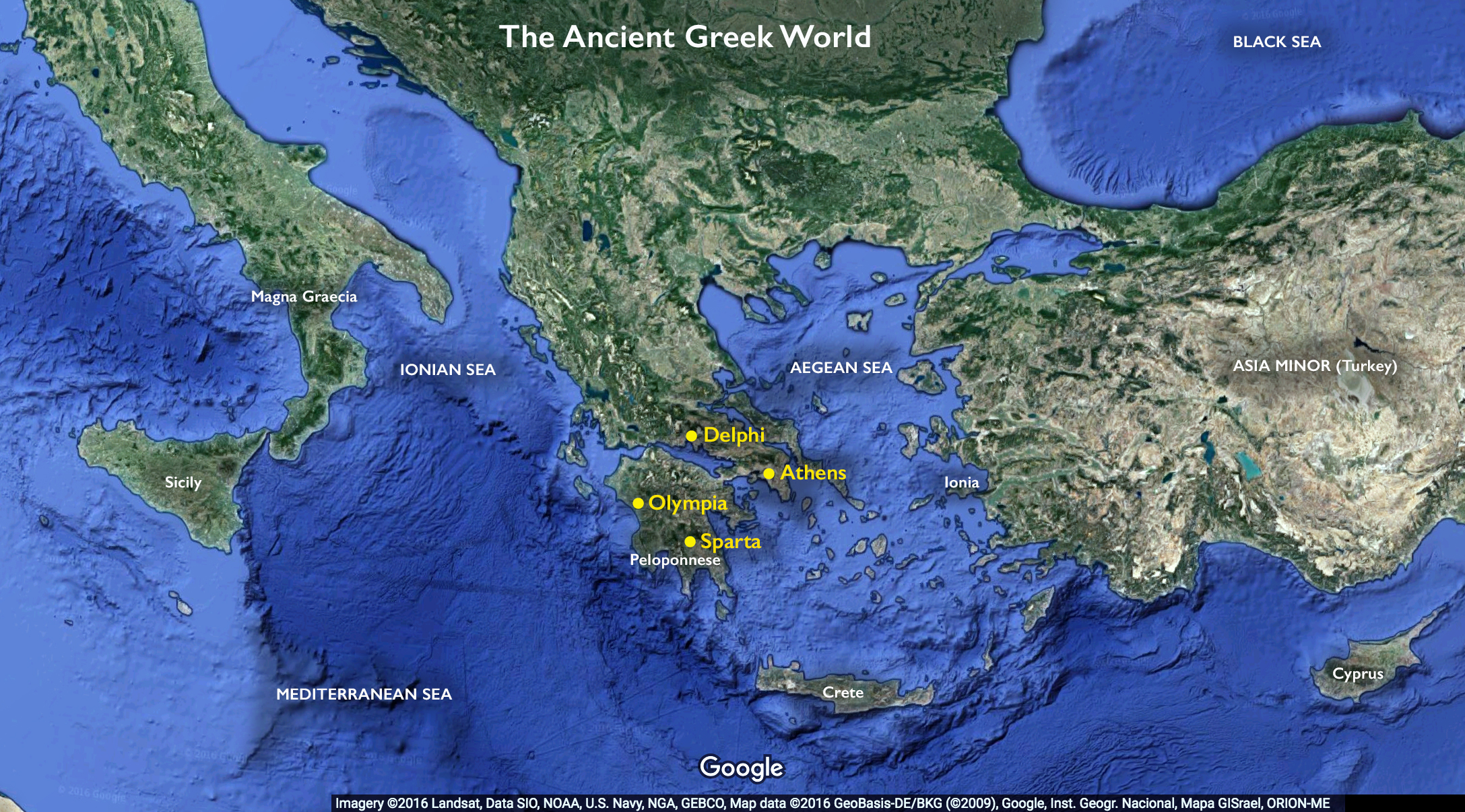
Ancient Greek world map (underlying map © Google)
The chapter is framed by the rise of two empires, that of Macedonia in the fourth century B.C.E. and that of Rome in the second and first centuries B.C.E. At the beginning of the fourth century, people who identified as Greek lived across the eastern Mediterranean and the Black Sea, and after the conquests of Alexander the Great and the establishment of Hellenistic kingdoms at the end of the century, Greek cities were established in Europe, north Africa, and Asia as far east as Bactria (modern Afghanistan). This chapter is organized primarily thematically, considering art and architecture within its original historical context.
Conquests of Philip and Alexander
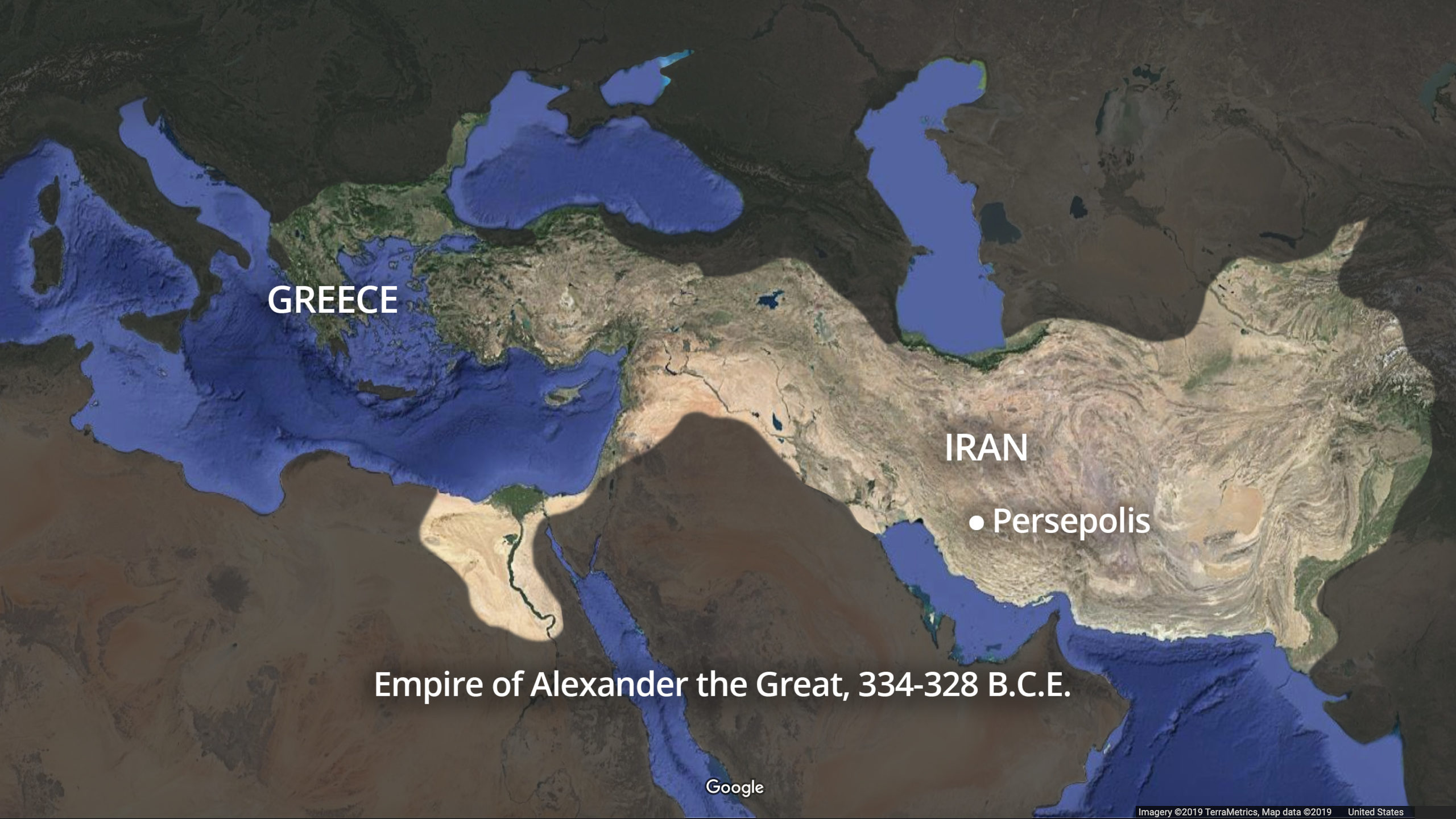
Empire of Alexander the Great, 334–328 B.C.E.
After Philip II, king of Macedonia, came to power in 359 B.C.E., he began to expand his rule south into mainland Greece through a combination of diplomatic and military efforts. Ancient Macedonia, which occupied a territory in the northeastern Greek peninsula that today is divided primarily between the modern countries of Greece and North Macedonia, had a hereditary monarchy as its governmental system, contrasting to the city-states (poleis) of southern Greece.
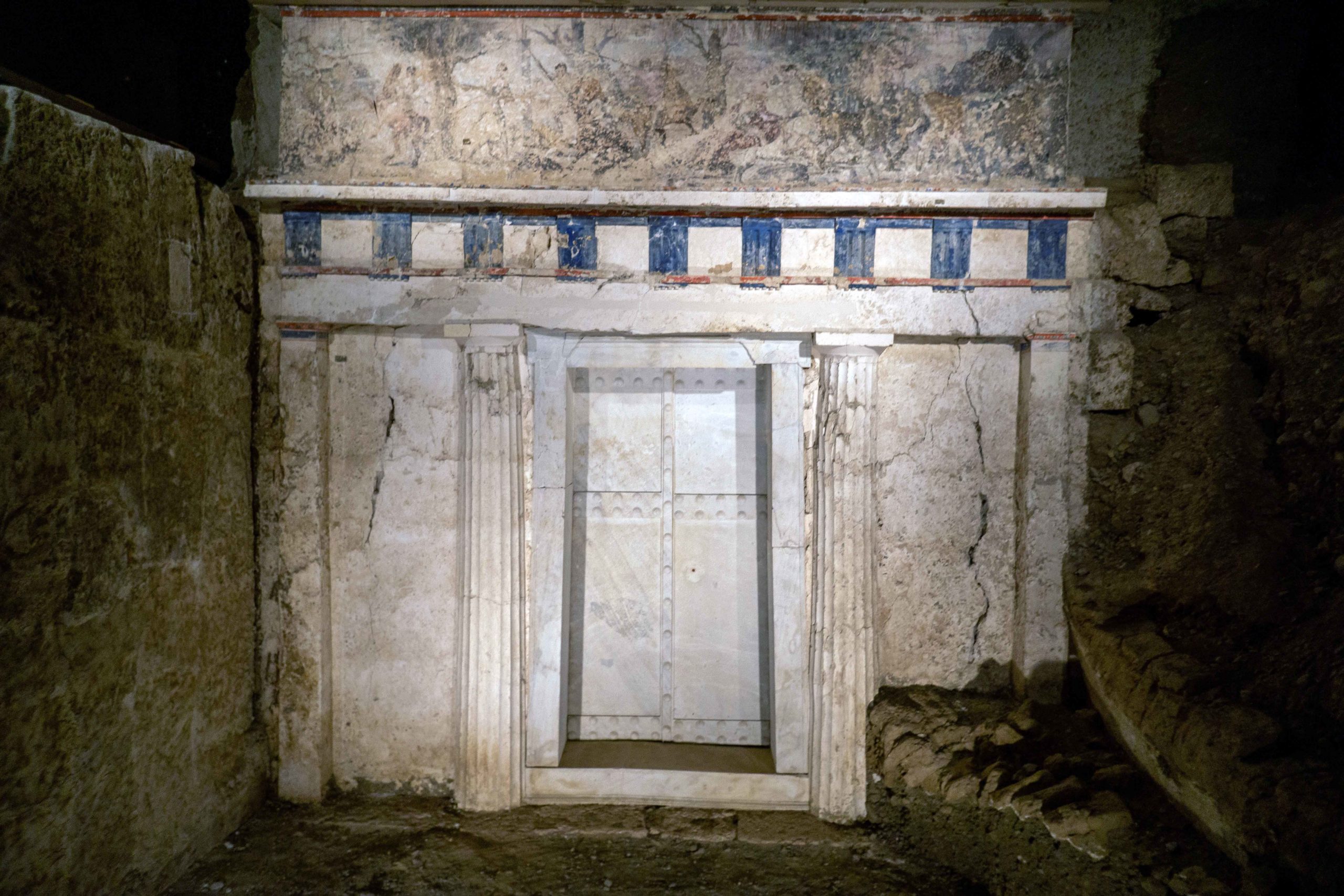
Façade of Tomb II, Vergina, c. 330–320 B.C.E., Macedonia, Greece (photo: Graham Mulligan, CC BY-NC 2.0)
There were cultural differences between the southern Greeks and Macedonians as well. Macedonian Greek was its own dialect, and the cultural institutions that surrounded their monarchy, with its associated societal hierarchy, set them apart.
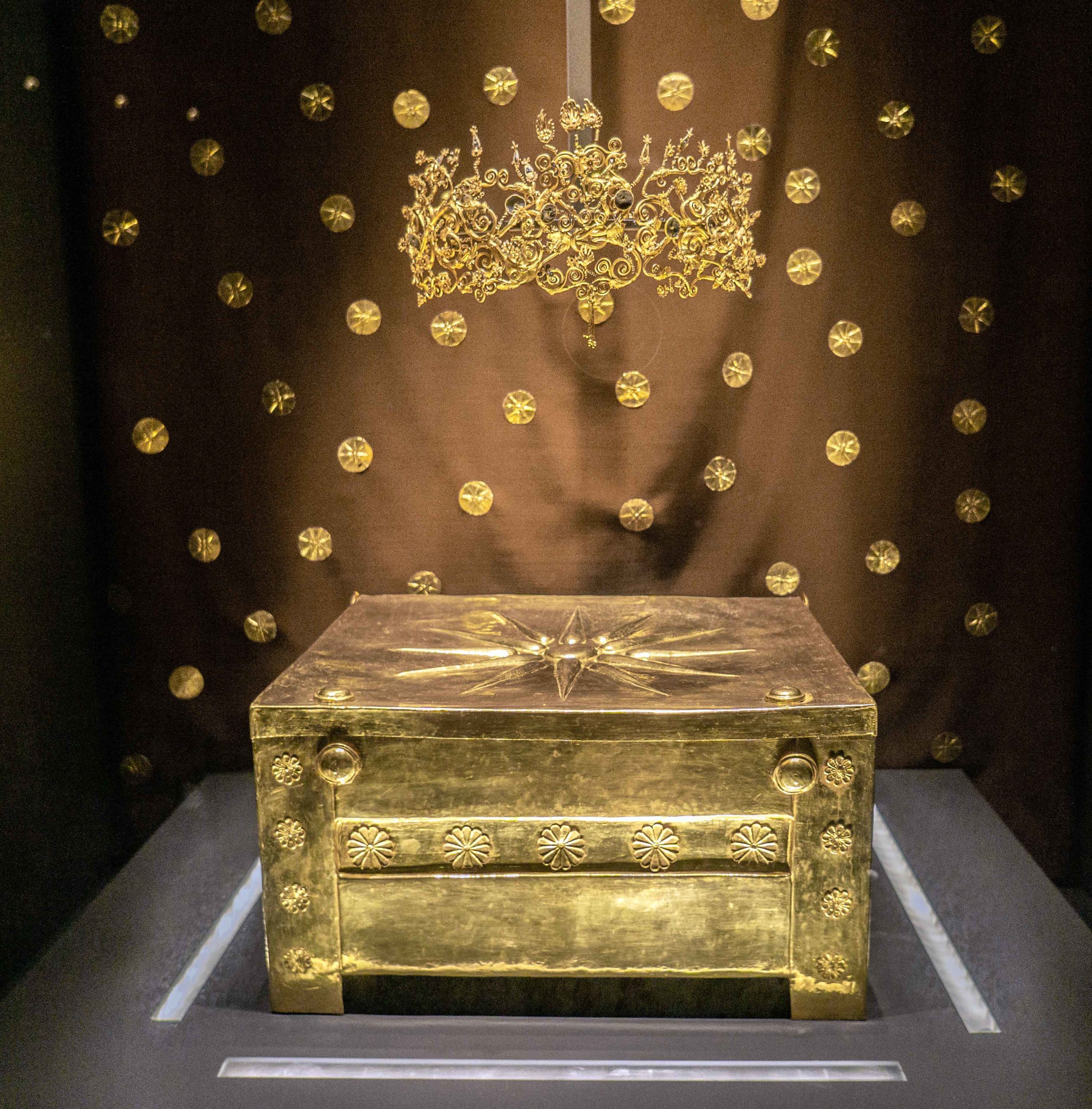
Diadem (above) and larnax (below), found inside Tomb II, Vergina, c. 330–320 B.C.E., both are gold and enamel, Macedonia, Greece (Museum of the Royal Tombs of Aigai; photos: Graham Mulligan, CC BY-NC 2.0)
Evidence of this cultural and political system can be seen in the lavishly decorated tombs filled with rich grave goods found at a number of sites in Macedonia, notably the royal burials at Vergina (ancient Aigai), as well as the monumental architecture built for the king and his court, such as the palace and other buildings at Pella with their impressive pebble mosaics.
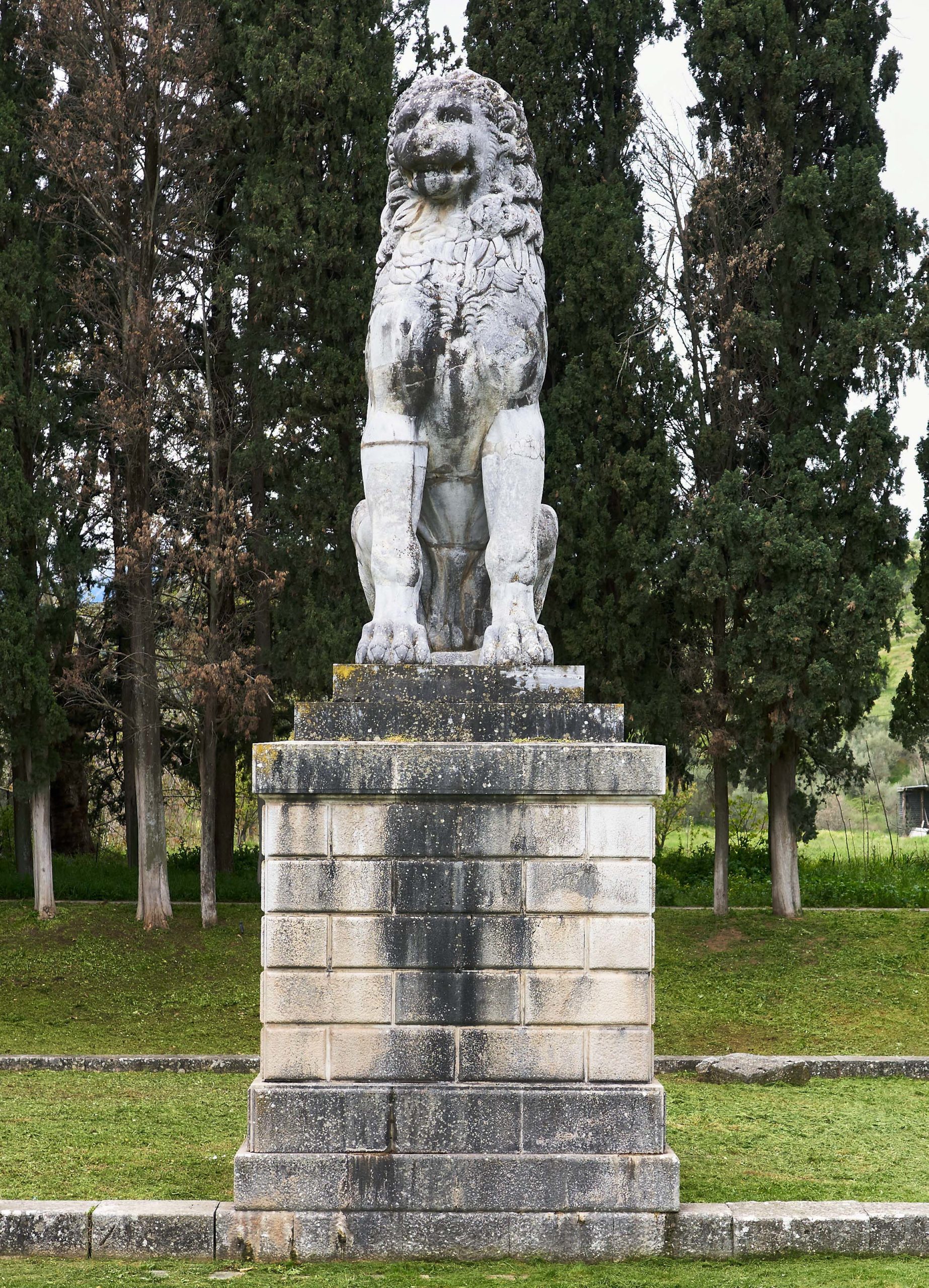
The Lion of Chaironeia (restored) that marked the grave of the fallen Thebans in Boeotia who fought against Philip II of Macedon at the Battle of Chaironeia in 338 B.C.E., 8.5 m high, Chaironeia, Boeotia, Greece (photo: George E. Koronaios, CC BY-SA 4.0)
After the Battle of Chaironeia in 338 (when Philip’s army defeated combined Athenian and Theban forces), Philip gained control of most of Greece. Philip placed himself as the leader of the newly formed League of Corinth, which included all of the Greek states except Sparta. The stated goal of the federation was to preserve peace among the Greek cities, but this was enforced by Macedonian dominance and military might. At its first meeting, the league ratified Philip’s plan to invade the Persian Empire in retaliation for the Persian Wars in the previous century.
Philip was assassinated in 336 and unable to complete his plans. They were instead taken on by his son, Alexander (the Great), who ascended to the throne at the age of 20 after his father’s unexpected death. Over the next thirteen years until his own death in 323, Alexander and his army embarked on a military campaign of conquest that established Alexander’s rule over a territory of approximately two million square miles. It stretched from Greece and Egypt in the west across Mesopotamia and Persia and into Central Asia and India.
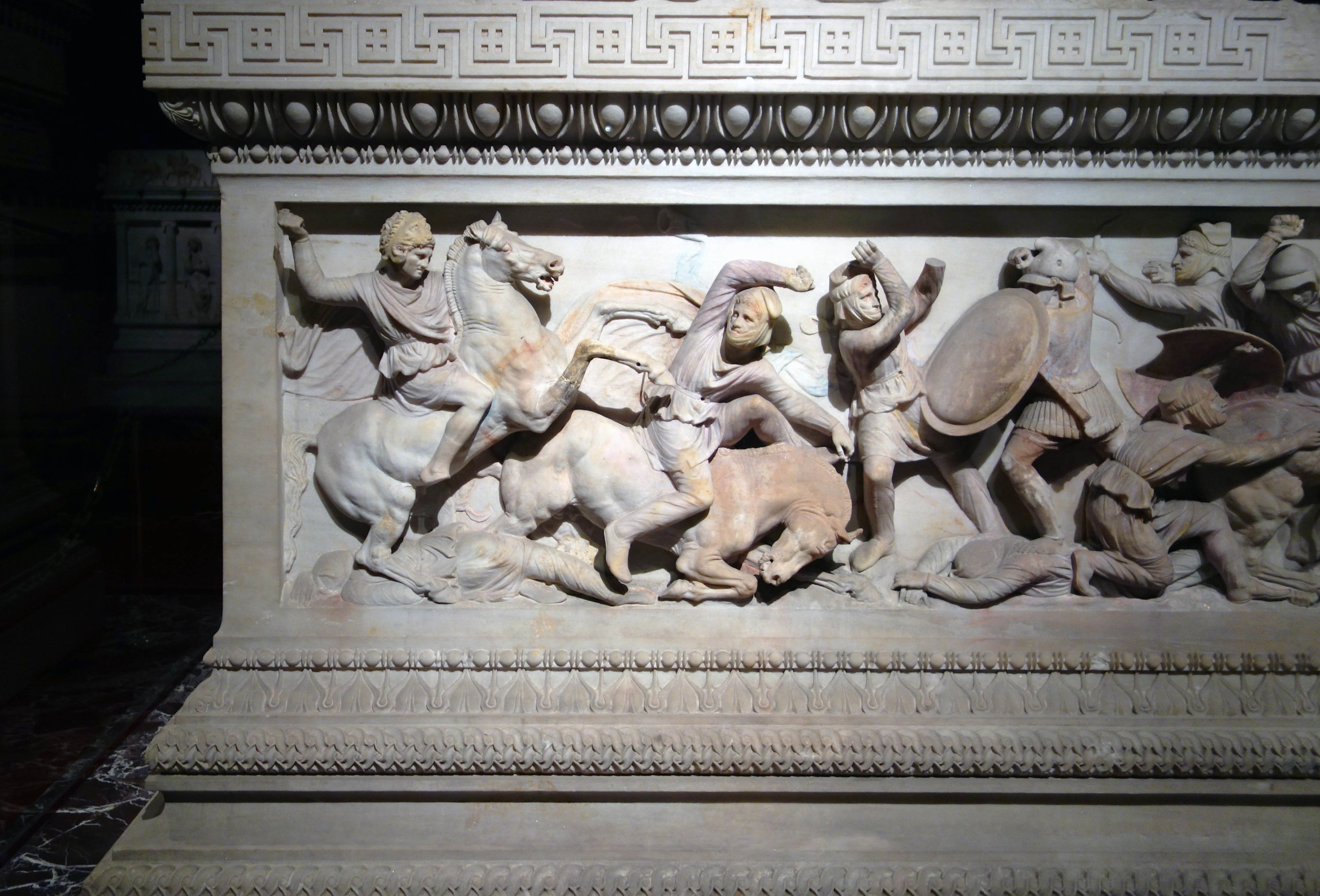
The Alexander Sarcophagus, c. 312 B.C.E., Pentelic marble and polychromy, found in Sidon, 195 x 318 x 167 cm (İstanbul Archaeological Museums; photo: Steven Zucker, CC BY-NC-SA 2.0)
Alexander carefully cultivated his image as a god-like hero, founding cities he named after himself, and commissioning portraits. Alexander tightly controlled his imagery, allowing only one sculptor, Lysippos, and one painter, Apelles, to create portraits that depicted the king with distinct, idealized features as a young conqueror. While none of these original portraits have survived, the type was influential, shaping Greek portraiture for centuries. Alexander’s successors commissioned and displayed portraits of the king and ordered images of themselves that emulated those of Alexander in order to connect themselves with his glory. This was the case for one of the earliest surviving portraits of Alexander from the Alexander Sarcophagus, which most likely served as the burial place for a king of Sidon in Lebanon. He was a Phoenician king who owed his position to Alexander and commemorated this connection with Greek-style images of Greeks and Persians in battle or hunts on his sarcophagus.
Watch a video about conquests of Philip and Alexander
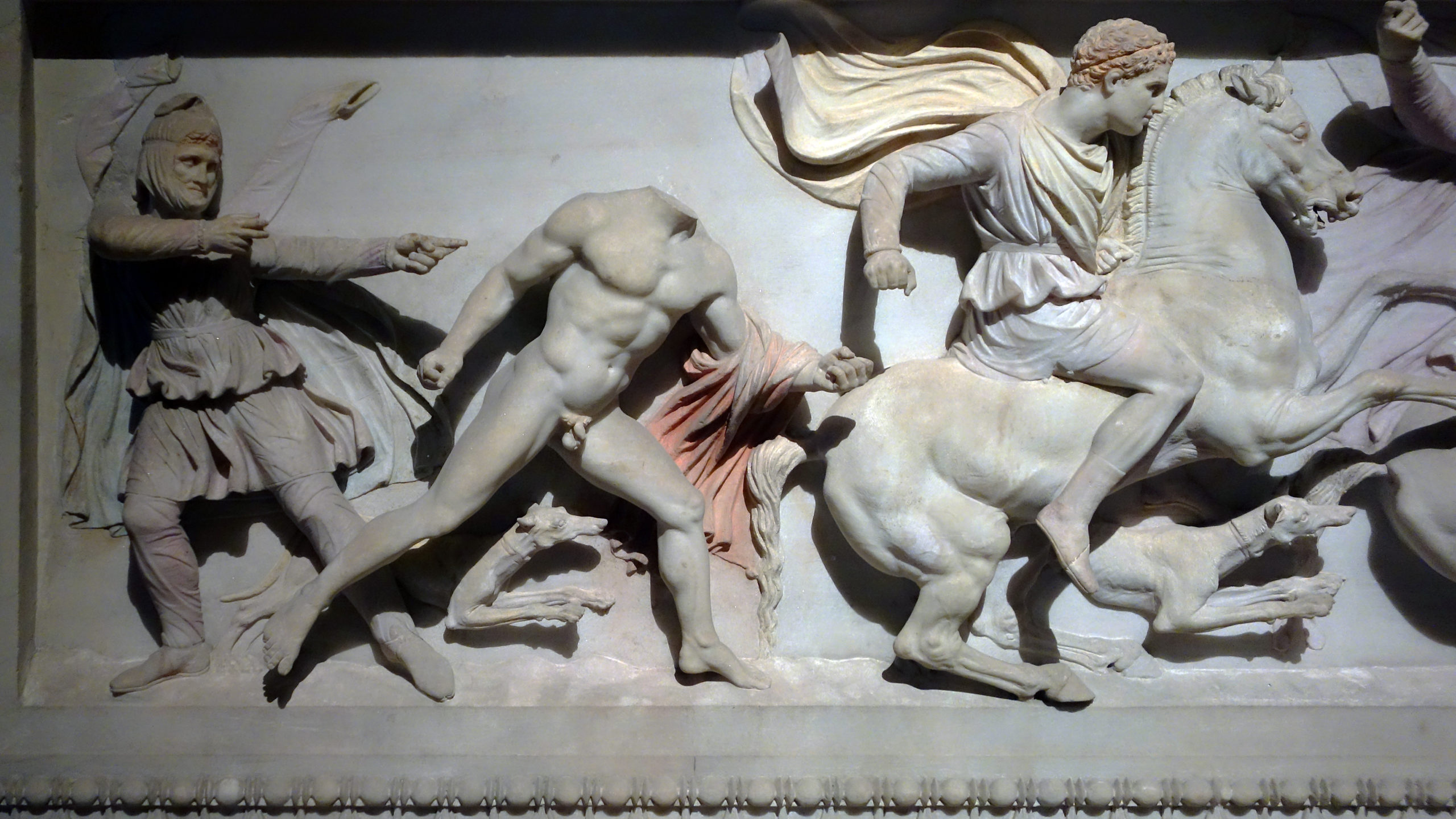
/1 Completed
Hellenistic Art and Changing Ideas of Greek Identity
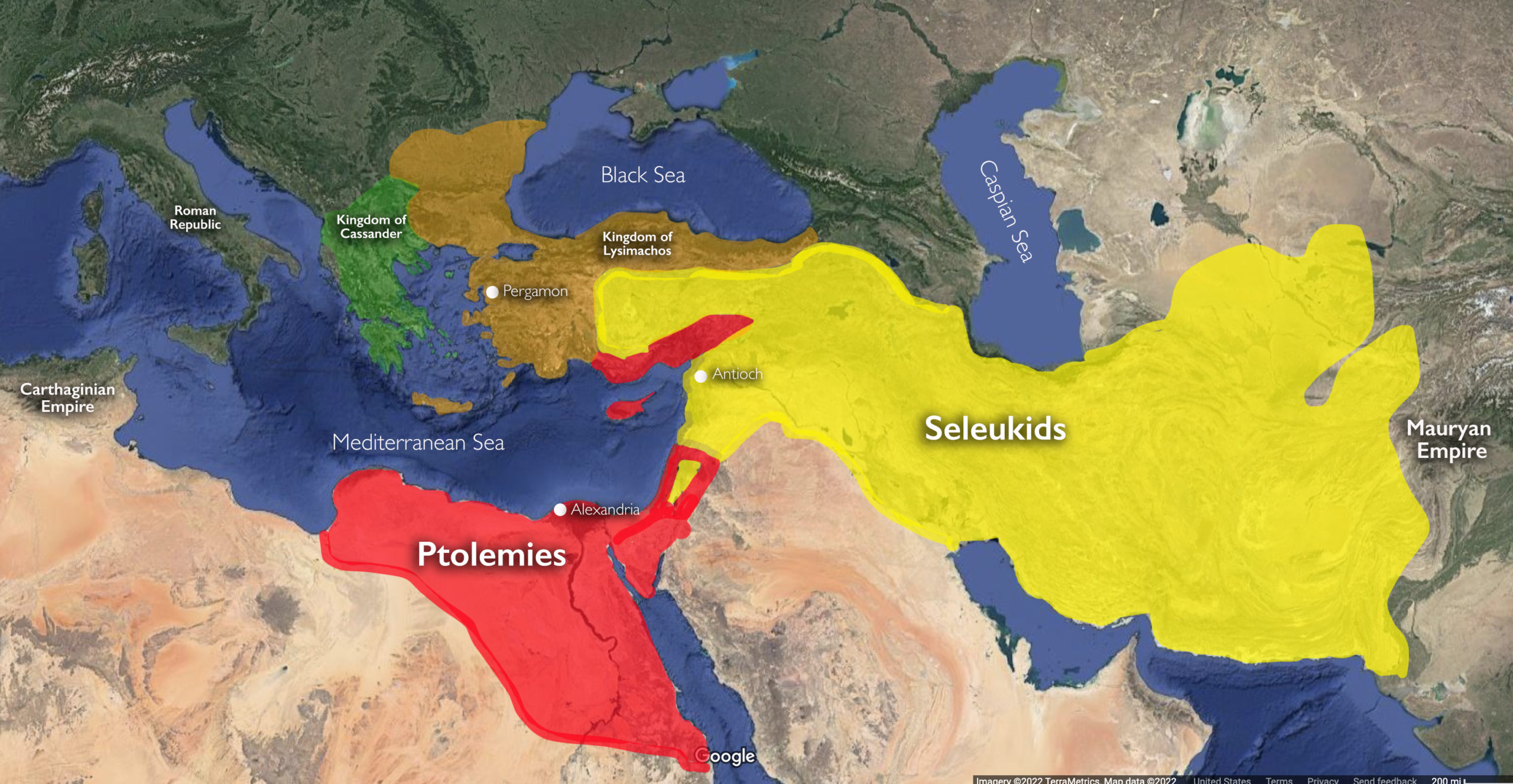
Map of the Hellenistic kingdoms, with some important cities, c. 300 BCE (underlying map © Google)
Alexander’s empire only lasted as long as he lived, and after his death most of his territory was split between his generals, who each established their own kingdoms. For the next three hundred years, the eastern Mediterranean and much of West Asia were dominated by these kingdoms. Three major centers of power emerged: Egypt under the Ptolemies, the parts of West Asia under the Seleukids, and Greece and Anatolia, which saw various rulers, notably the Attalids of Pergamon. As the kings fought for dominance, warfare was nearly constant and the borders of their kingdoms changed regularly. Large, cosmopolitan cities like Antioch, Alexandria, and Pergamon emerged with diverse populations and wealthy upper classes.
As part of their establishment and maintenance of power, most Hellenistic rulers practiced cultural imperialism, promoting Greek language, culture, and religion in territories that previously did not identify as Greek. The period is now known as the Hellenistic period due to this spread of Greek (Hellenic) culture. Yet, this was not simply the imposition of Greek culture across passive, conquered peoples. These kings ruled over millions of people of different ethnicities who spoke numerous languages and worshiped various gods. The cultures, religions, and art of the conquered people influenced those of the conquerors in turn.
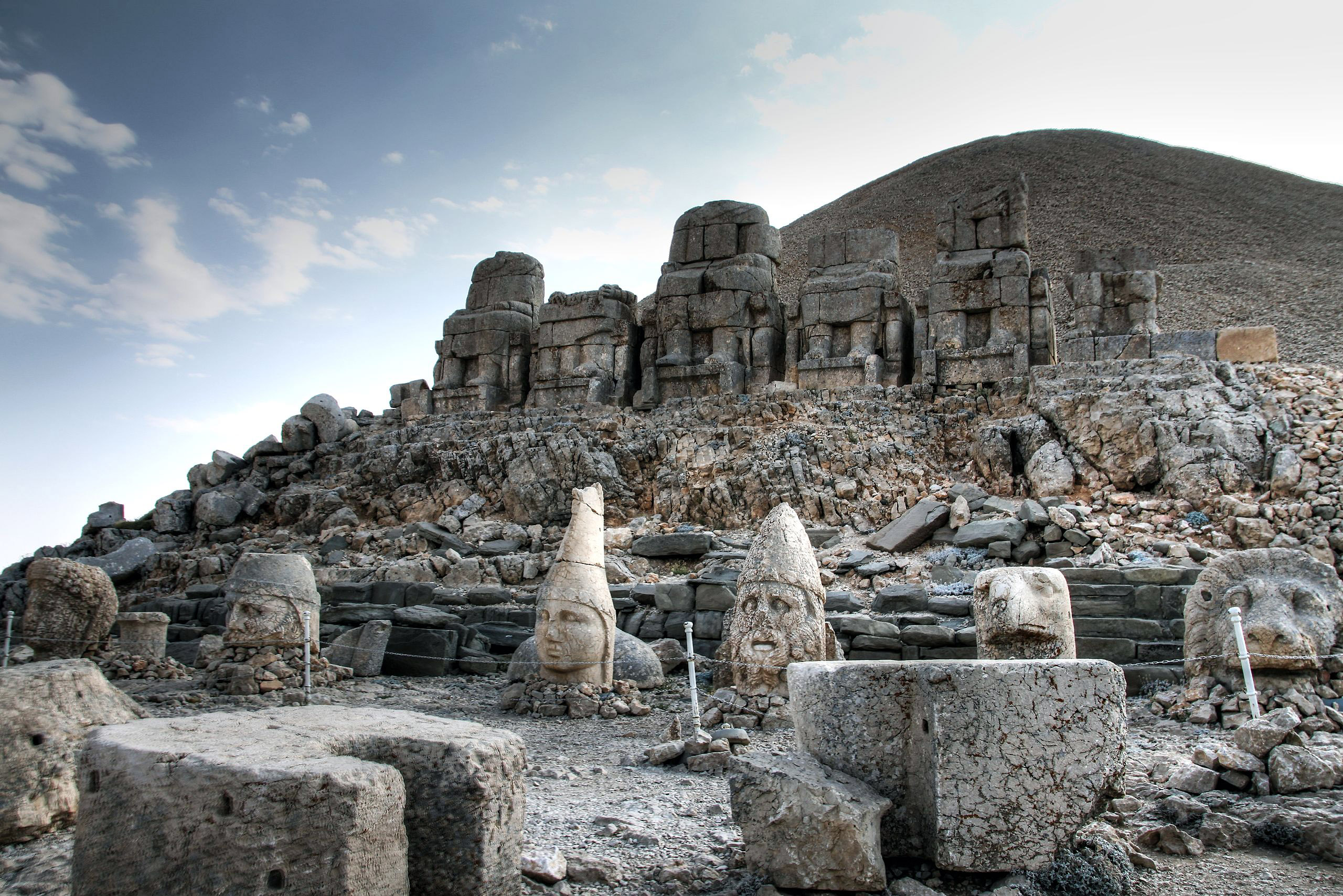
East terrace showing large statues around what is possibly a tomb, Nemrut Dag, c. 1st century B.C.E., Turkey (Nemrut Tümülüsü) (photo: Klearchos Kapoutsis, CC BY 2.0)
There is a large variation in what we identify as Hellenistic art, across the Hellenistic world and across the three centuries that we identify as the Hellenistic period. Yet, the Hellenistic world was intensely interconnected, with artistic ideas, trade, and people moving across huge swaths of territory. There were common cultural touchstones that connected these different areas, notably the spread of the common Greek language, the worship of Greek gods, and Greek artistic style and iconography. Yet, these were regularly re-interpreted on a local level by different populations, and the formation of art and identity was a constant negotiation that happened primarily on a local level. An examination of the funerary complex at Nemrut Dağ of Antiochos I, a king of Kommagnein the first century B.C.E., who traced his lineage from both Greek and Persian kings, provides an example of Hellenistic hybridity.
Watch a video about changing ideas of Greek identity

Nemrut Dağ (tomb of King Antiochus I Theos): The mausoleum is one of the most ambitious constructions of the Hellenistic period.
Read Now >/1 Completed
Hellenistic Sculpture: Power, Victory, and Drama
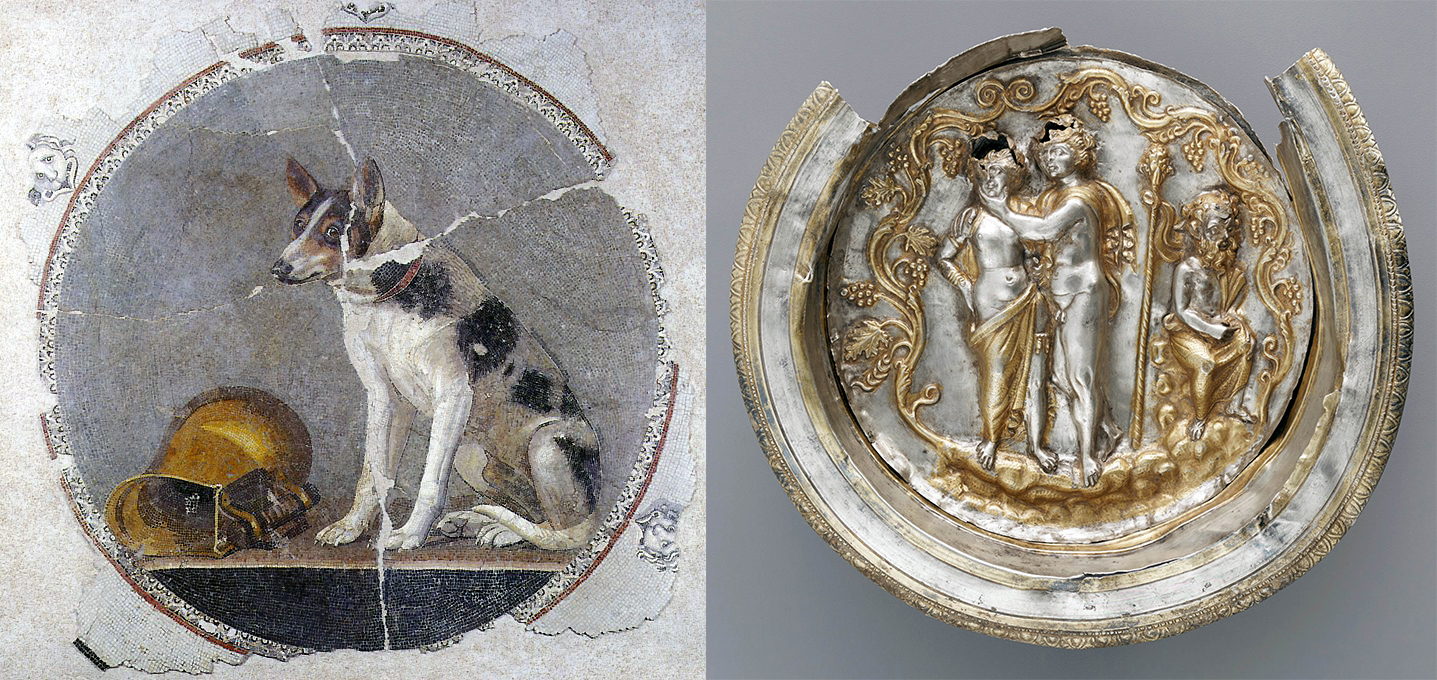
Left: Mosaic depicting a sitting dog, c. 2nd century B.C.E., Ptolemaic period, mosaic, Lower Egypt, Alexandria, El Shatby, Bibliotheca Alexandrina Site (Bibliotheca Alexandrina Museum); right: Bowl with a Medallion Depicting Dionysos and Ariadne, c. 100 B.C.E., silver with gilding, Asia Minor, 3.2 × 14.4 cm (The J. Paul Getty Museum, Villa Collection)
Aided by a more interconnected economic and political world, elites commissioned luxury goods like mosaics and metal wares that they displayed in their homes as signs of status. At the rulership level, art was used to advertise military victories, promote royal propaganda, and create new identities for their kingdoms and their people. Statues like the Nike of Samothrace were erected in panhellenic sanctuaries as statements of military power.
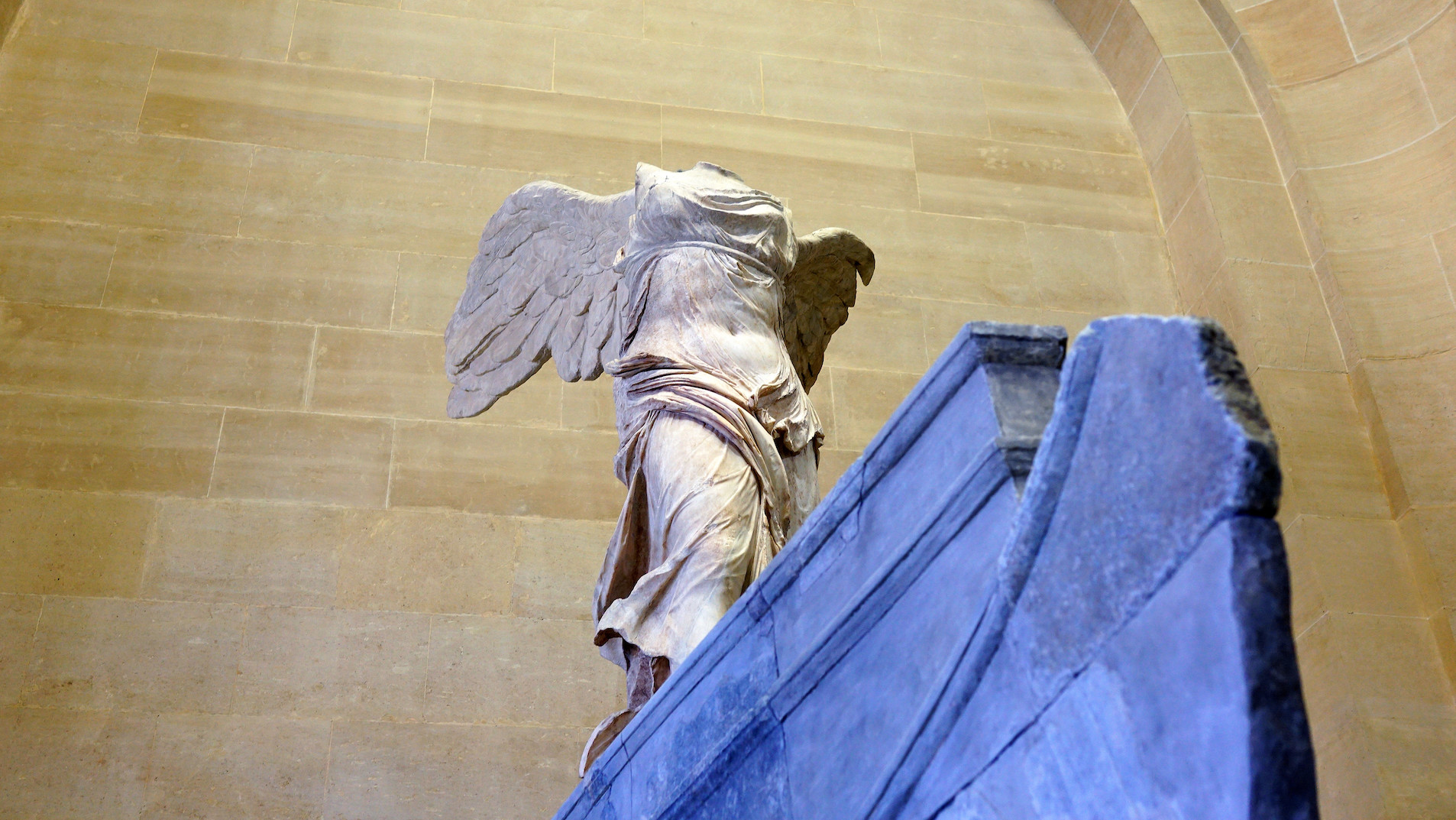
Nike of Samothrace (winged Victory), Lartos marble (ship), Parian marble (figure), c. 190 B.C.E., 3.28 meters high (Louvre, Paris; photo: Steven Zucker, CC BY-NC-SA 2.0)
Reflecting the changing societies and cultures that emerged in the Hellenistic period, sculpture moved away from the idealism of the Classical period, embracing a wider variety of subjects and styles. Some Hellenistic statues, like the Nike of Samothrace, are dramatic and theatrical and require the viewer to engage with them physically by moving to different vantage points to view the artworks in their entirety.
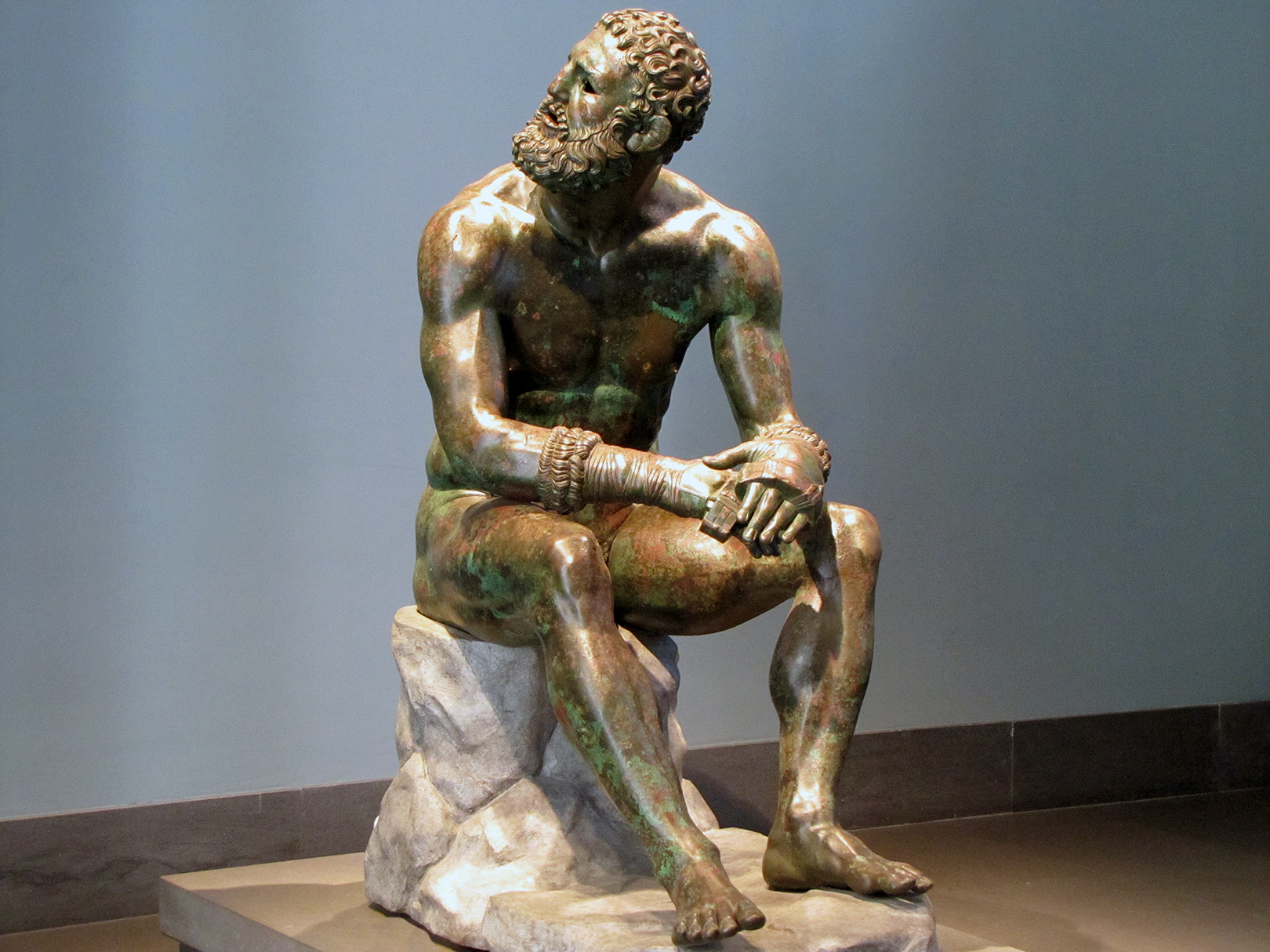
Apollonius, Boxer at Rest, c. 100 B.C.E., bronze, Hellenistic Period (Palazzo Massimo, Museo Nazionale Romano, Rome; photo: Steven Zucker, CC BY-NC-SA 2.0)
Others, like the Seated Boxer, embrace realism. The boxer depicts, not a young, idealized athlete, but a beaten, middle-aged man, reflecting changes in the role of athletics in Hellenistic society and the growth of professional athletes. Yet, the Seated Boxer could depict a different version of victory. This could be not an image of defeat, but rather the veteran boxer, who even when he looks defeated, can stand back up and win a bout in the ring.
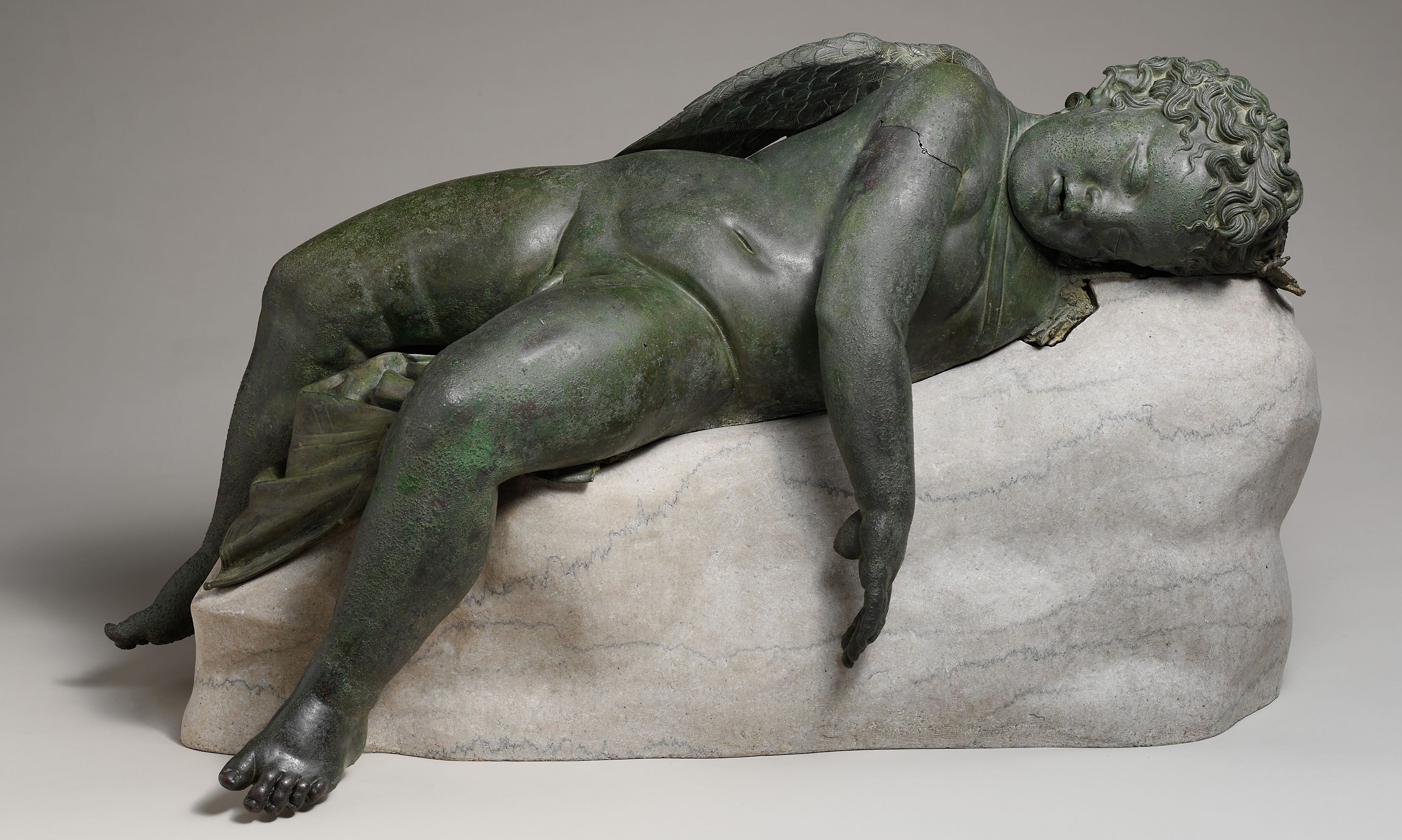
Bronze statue of Eros sleeping, 3rd–2nd century B.C.E., bronze, 16 1/2 × 14 × 33 9/16″ / 41.9 × 35.6 × 85.2 cm (The Metropolitan Museum of Art).
Other statues reflect on the contrast between power and vulnerability. Sleeping figures, like the Barberini Faun and the Eros Sleeping, became popular. The Eros statue shows the god, whose arrows of erotic love could fell even the most powerful god, as an adorable, sleeping toddler.
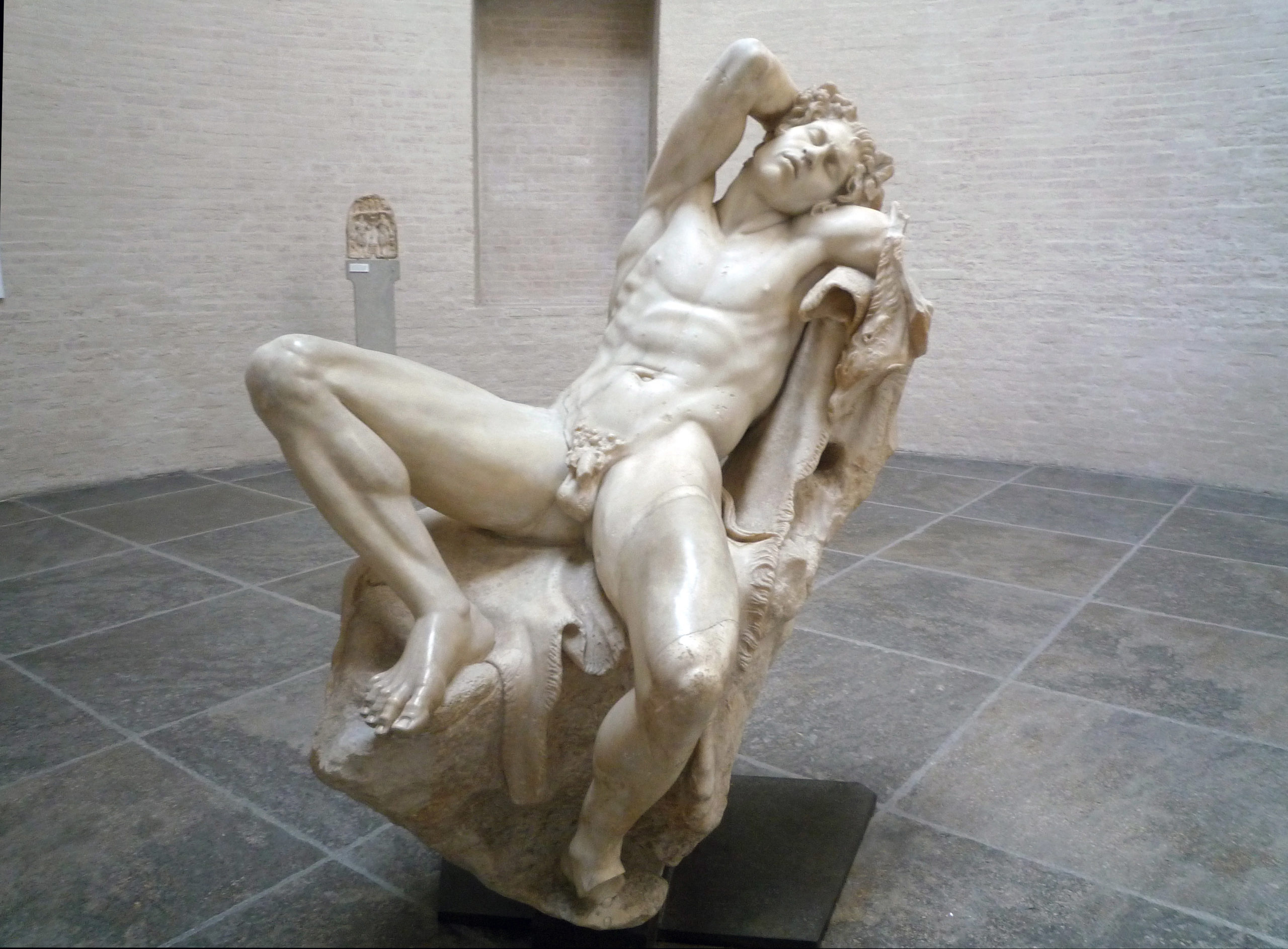
Barberini Faun, c. 220 B.C.E., Hellenistic Period (Glyptothek, Munich; photo: Steven Zucker, CC BY-NC-SA 2.0)
The Barberini Faun depicts the physically large and muscled form of a satyr, a part animal, part human creature, asleep and distinctly vulnerable. He is also overtly sexualized in a way that earlier male nudes, and even most Hellenistic male nudes, were not. This new depiction of the male form reflects changes in ideas of sexuality in the Hellenistic period. While sexual relationships between two men were common in the earlier periods (see earlier chapter), the roles that each lover played were strictly and socially defined, as the relationships were seen to benefit society. In the Hellenistic period, there were changes in how people saw themselves within society, and where they looked for happiness and identity. As citizens of large kingdoms, rather than small city-states, people were more connected to the rest of the world through trade and political networks, and those that lived in large, cosmopolitan cities regularly came into contact with people of different ethnicities and cultures. Yet, many felt disconnected from their distant monarchical rulers, and often did not feel a common identity with their closest neighbors. People now frequently looked to family and personal relationships for happiness and identity, rather than their place within a civic structure. Sexual relationships were seen as one way to pursue happiness, resulting in a subsequent relaxing in the strict definitions of sexual roles. The Barberini Faun is illustrative of this change, as a mature man could now be seen as an object of desire.
Watch videos about Hellenistic Sculpture and themes of power, victory, and drama
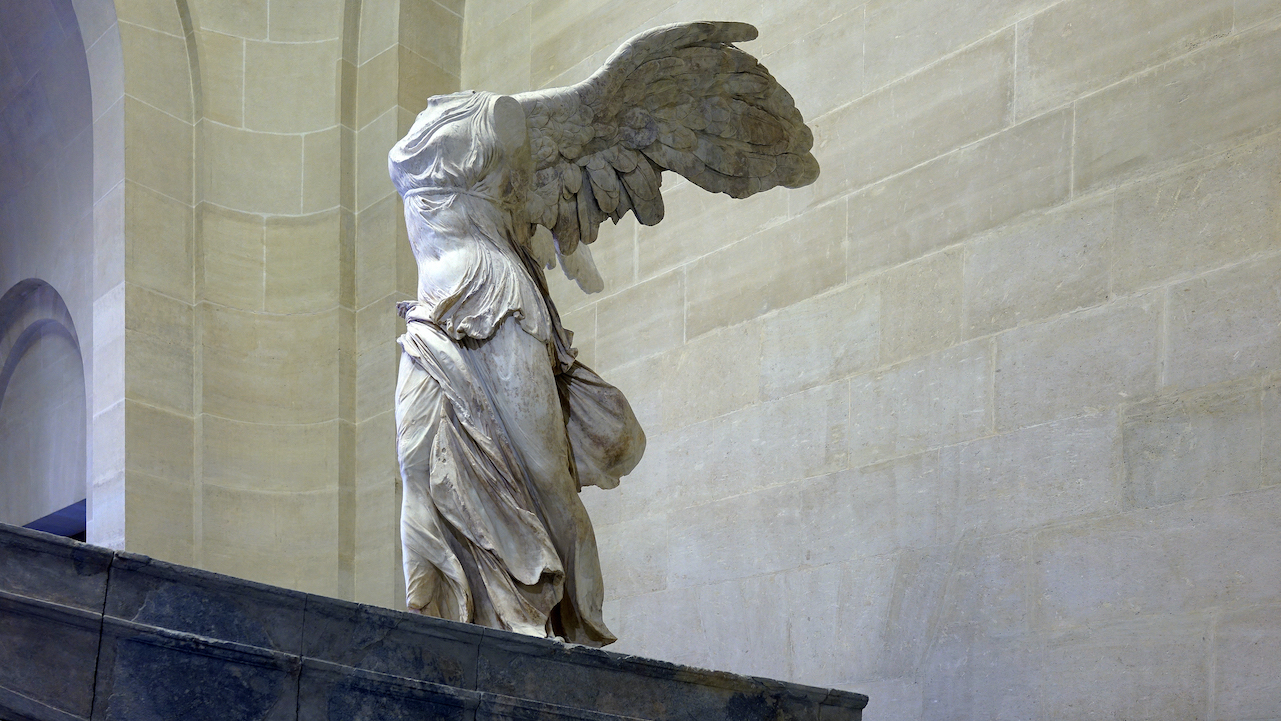
Nike (Winged Victory) of Samothrace: The flying personification of victory (nikē in Greek means victory) alights on top of the ship, announcing a naval triumph.
Read Now >
Apollonius, Boxer at Rest (or The Seated Boxer): Look closely to see bloody wounds and a lifetime of scars on this defeated athlete.
Read Now >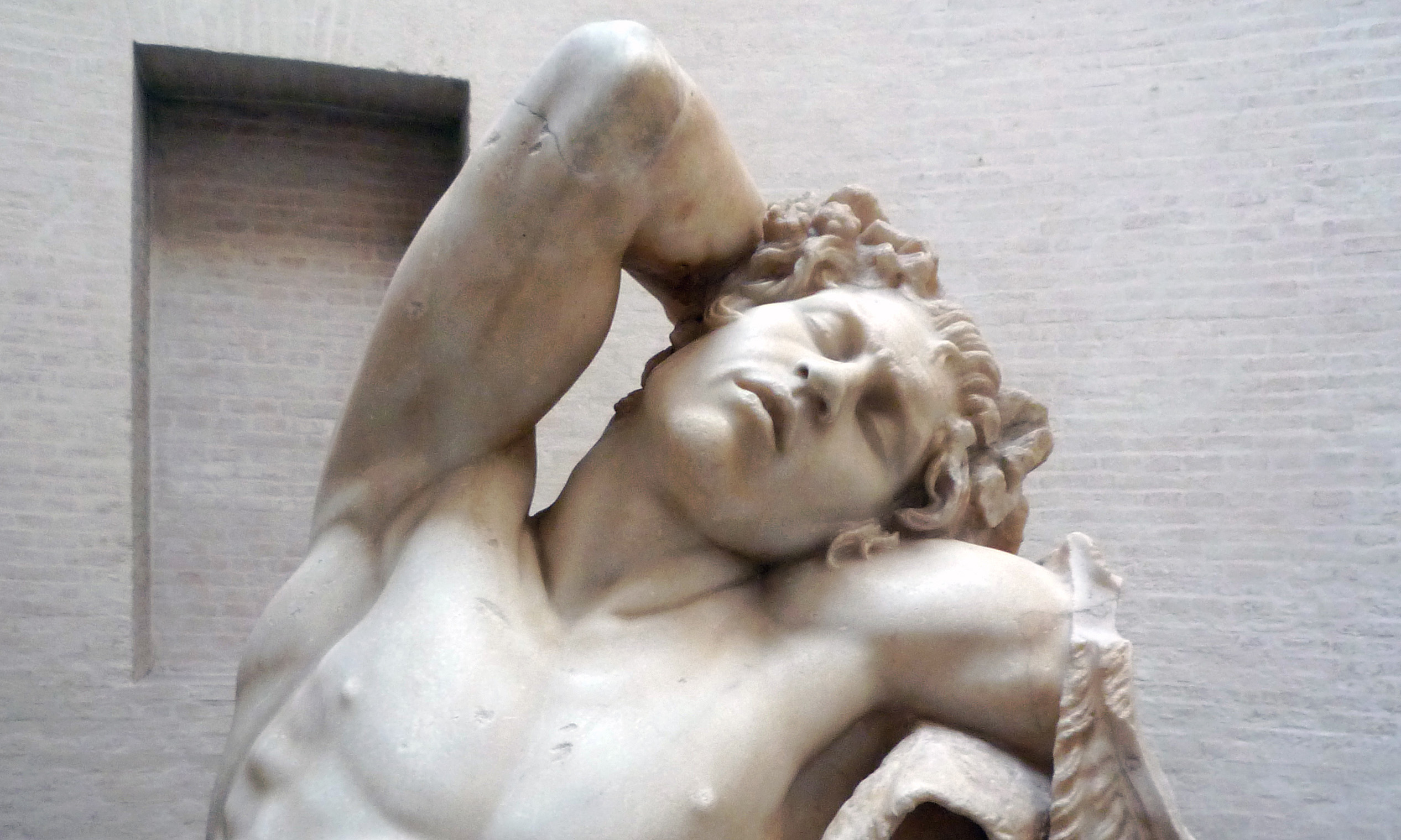
Barberini Faun: Part man, part goat, this companion of the god of wine relaxes after a night of drinking.
Read Now >
Bronze statue of Eros sleeping: What did this sculpture of Cupid, quietly sleeping mean to the ancient Greeks?
Read Now >/4 Completed
Pergamon
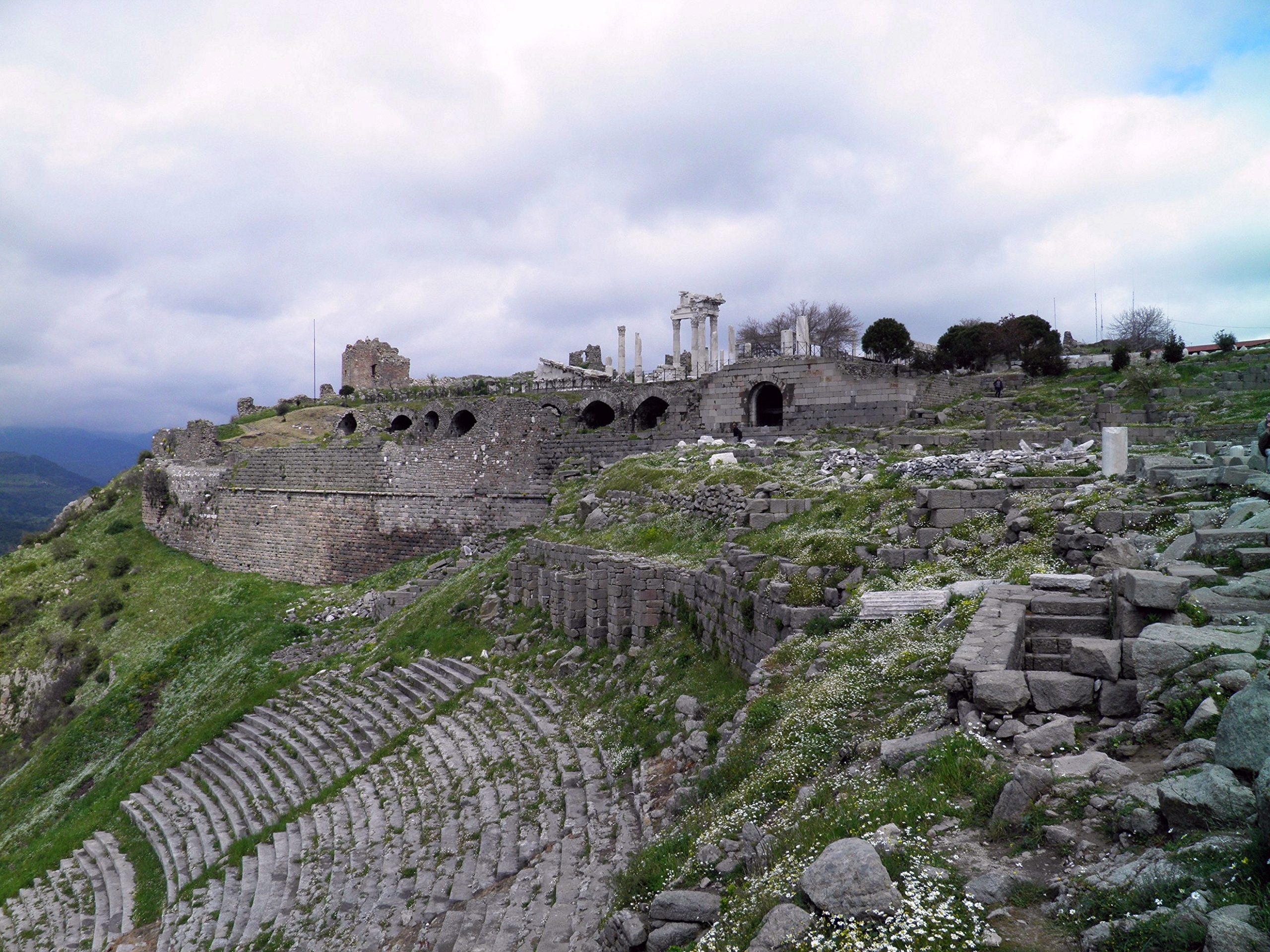
Acropolis, Pergamon (photo: Carol Raddato, CC BY-SA 2.0)
In Anatolia, the kingdom of Pergamon, like Athens in the fifth century, invested heavily in art and culture. Pergamon was a distinctly Hellenistic entity, emerging as a power in the early third century B.C.E. after the first king of Pergamon, Philetairos, broke away from Lysimachos, who had taken Anatolia after Alexander’s death. Philetairos took Lysimachos’s vast fortune with him, and he and his successors, the Attalids, used it to expand their kingdom until they controlled most of western Anatolia. They did this primarily through military conquest, and commissioned numerous monuments to celebrate these victories.
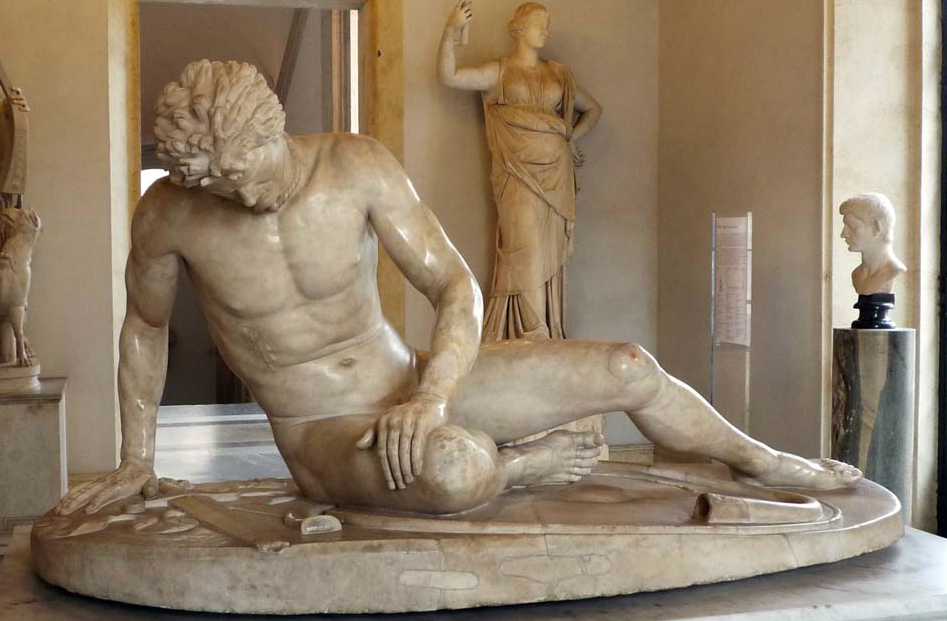
Dying Gaul, ancient Roman marble copy of a lost bronze Greek sculpture, c. 220 B.C.E., Hellenistic Period (Capitoline Museum)
One of these was a sculptural group erected in the Sanctuary of Athena in Pergamon that commemorated their victories against a group of people known today as the Gauls. The Gauls were a Celtic people who, beginning in the third century B.C.E., moved into mainland Greece and Anatolia, conducting raids on Greek cities and fighting a series of battles against various kings and cities. In their victory monuments, the Attalids followed the model of the fifth-century Athenian artworks that commemorating their victories against the Persians. The Attalids promoted their defeats of the Gauls as a triumph of a specifically Greek civilization over the non-Greek barbaric other.
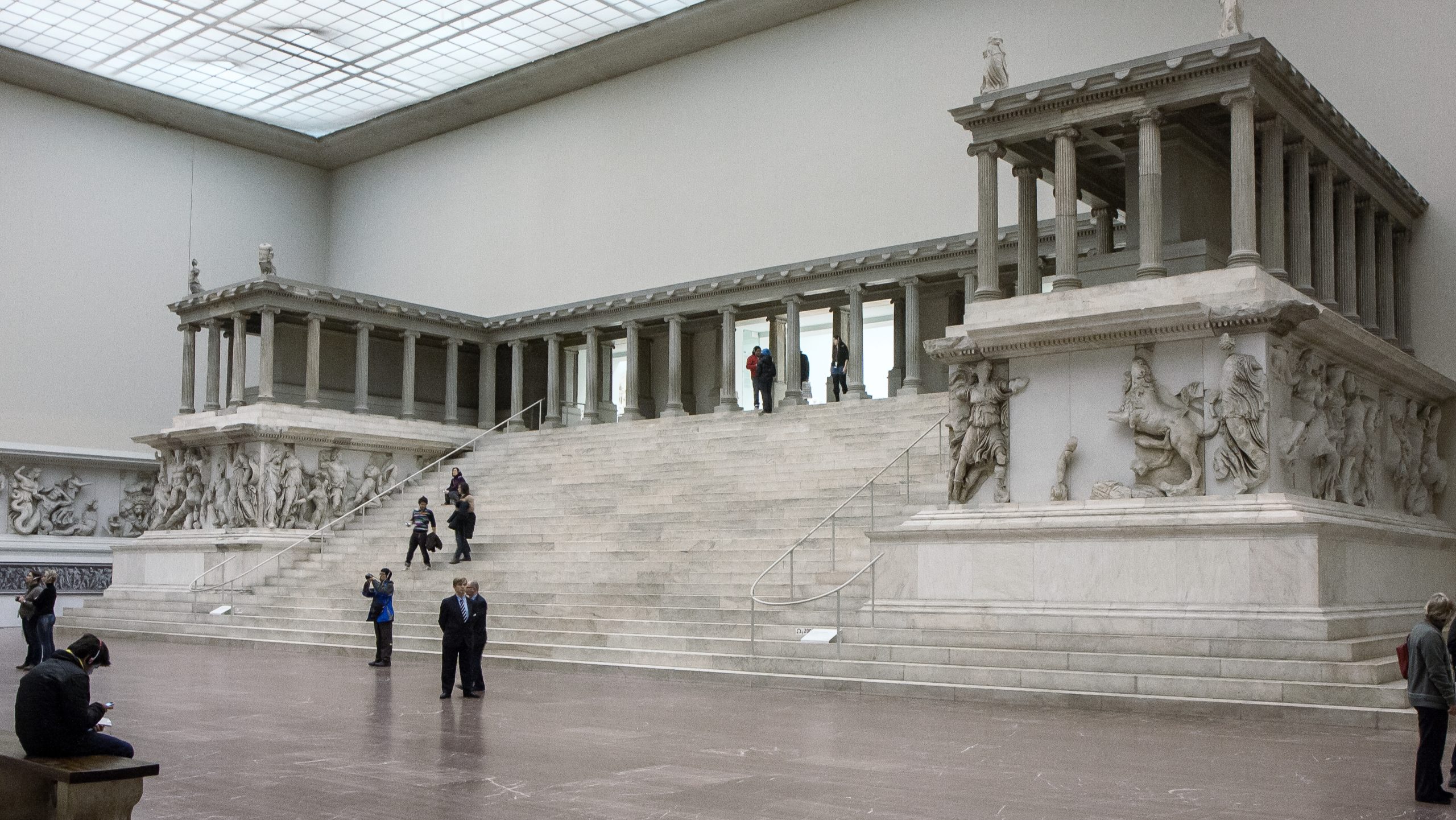
The western side of the Pergamon Altar as reconstructed in the Pergamon Museum in Berlin
Sculptural victory monuments over the Gauls were only one type of a number of monuments erected by the Attalids in their capital city of Pergamon. The Attalids built their new city, modeled architecturally on earlier Greek poleis, at a site that had previously been occupied by an Anatolian town. The Pergamenes were both Greek and Anatolian, and their cultural identity emphasized their descent from Greek heroes and connections to the mainland through shared history, as well as their shared past with other Anatolian cities. The highlight of this architectural program was the Pergamon Altar. The Altar, located in a prominent location on the acropolis in Pergamon, was lavishly decorated with sculpture, including a frieze depicting the battle of gods and giants (the gigantomachy) on the exterior and another that represented the life story of Pergamon’s most important hero, Telephos, on the interior.
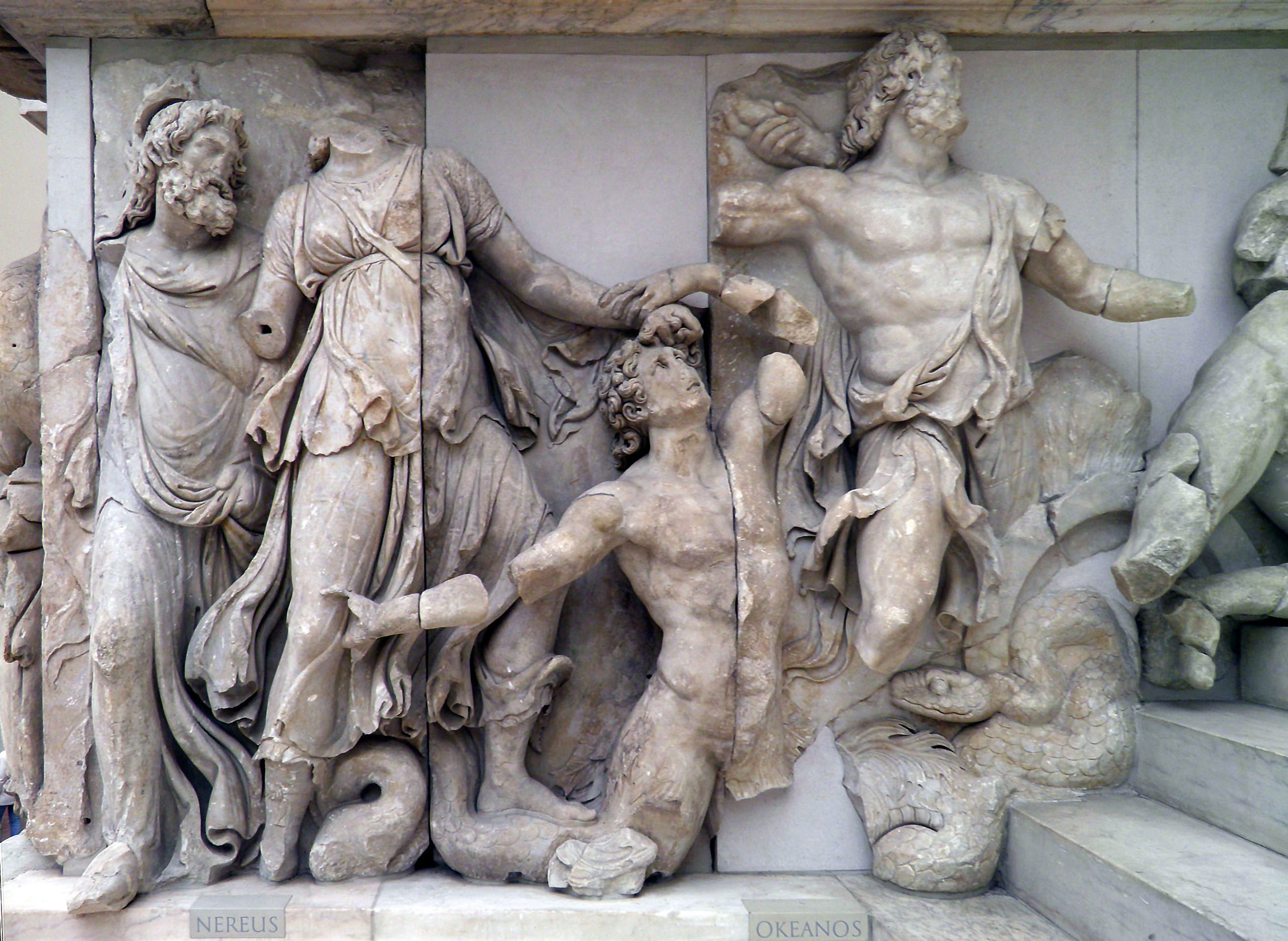
North side of grand staircase, Pergamon Altar (photo: Carole Raddato, CC BY-SA 2.0)
The gigantomachy frieze is one of the largest surviving sculptural compositions to survive from the Greek world, originally depicting somewhere between 100 and 200 battling figures, and is now regarded as one of the great masterpieces of Hellenistic art. The gigantomachy was one of the most popular subjects in Greek architectural sculpture, and was regularly used as an allegory for the triumph of civilization over barbarism. On the altar, it likely commemorates Pergamene military victories, as well as celebrating Pergamon, its kings, citizens, and patron gods.
Watch videos and read essays about Pergamon
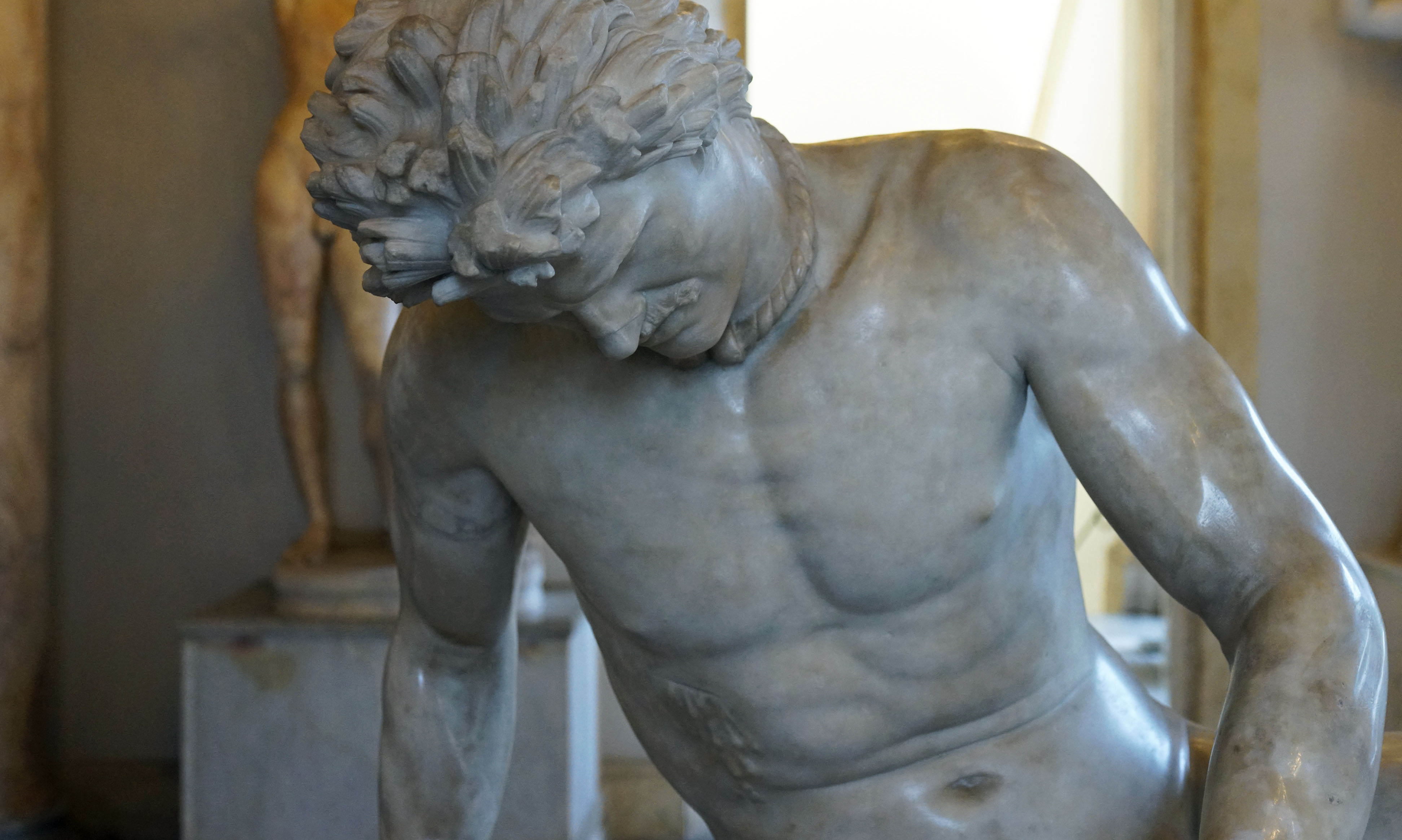
Dying Gaul and Ludovisi Gaul: What did these sculptures of dying Gauls have to do with power in Pergamon?
Read Now >
The Pergamon Altar: Ancient viewers would have first approached the Altar from its rear, where the god Zeus and goddess Athena, assisted by the hero, Herakles, decisively defeat their giant antagonists.
Read Now >/2 Completed
Rise of Rome
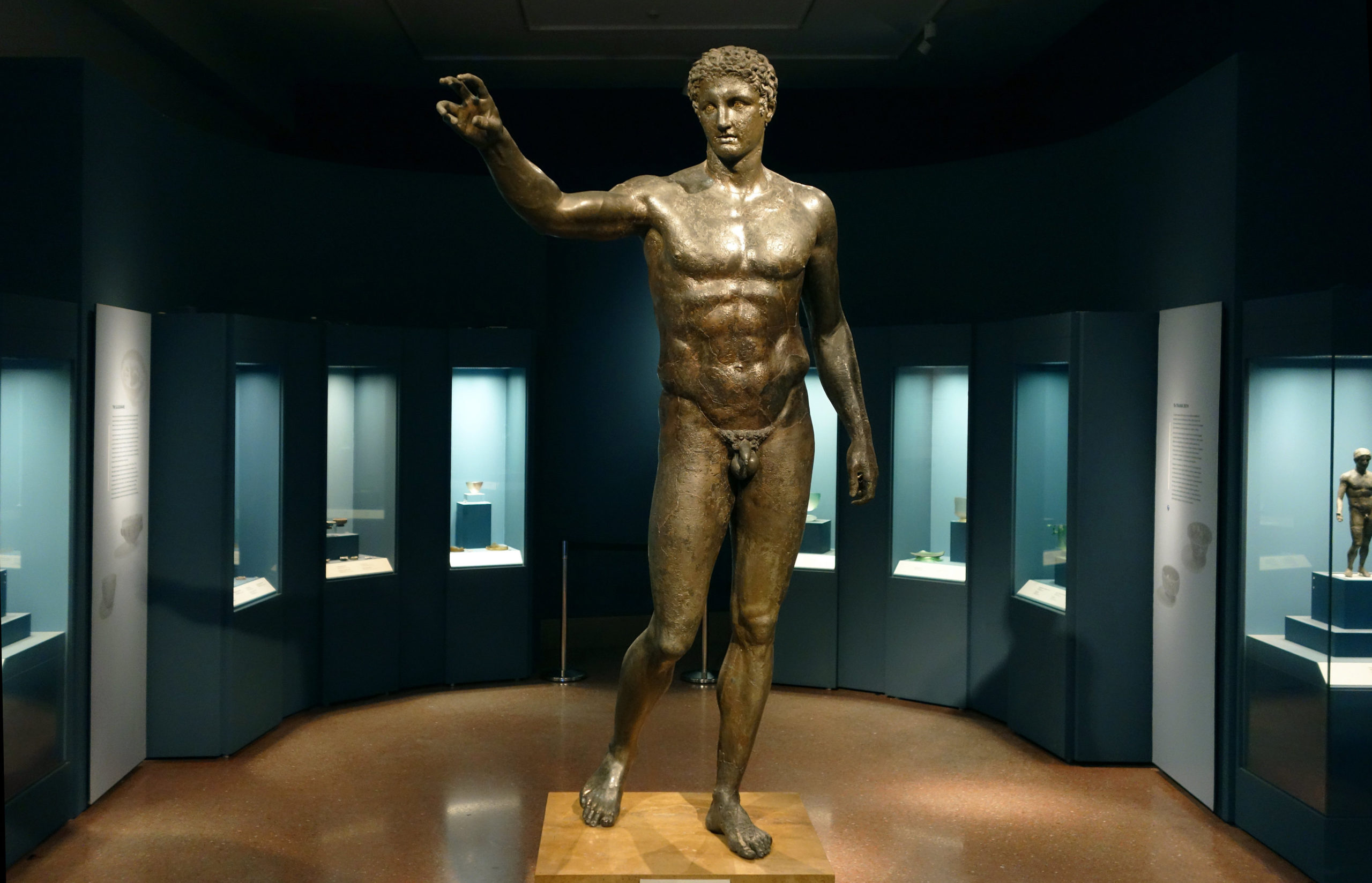
Antikythera Youth, 340–330 B.C.E., bronze, 1.96 m high (National Archaeological Museum, Athens, photo: Steven Zucker, CC BY-NC-SA 2.0)
As Rome conquered Greek territories, they began to actively collect Greek artworks. Statues and other artworks were removed from temples and other public spaces and shipped across the sea to Italy where they were displayed in the homes of wealthy Romans. Some of the artworks never made it to Italy as they were lost at sea as the ships that carried them wrecked. Some of these wrecks, such as the Antikythera Shipwreck, have been recovered in the modern era, and their cargo preserved statues, such as bronzes, that have not commonly survived, and provided insight into the Roman artistic trade.

Capitoline Venus, 2nd century C.E., marble, 193 cm (Capitoline Museums, Rome) (Roman copy of the Aphrodite of Knidos, a 4th century B.C.E. Greek original by Praxiteles)
The Romans also enthusiastically copied famous Greek artworks, like the Doryphoros and the Aphrodite of Knidos, and many of the best-preserved examples of these statue types have been found in Roman contexts. Other Roman artworks used Greek artworks as inspiration, transforming the original into something new.
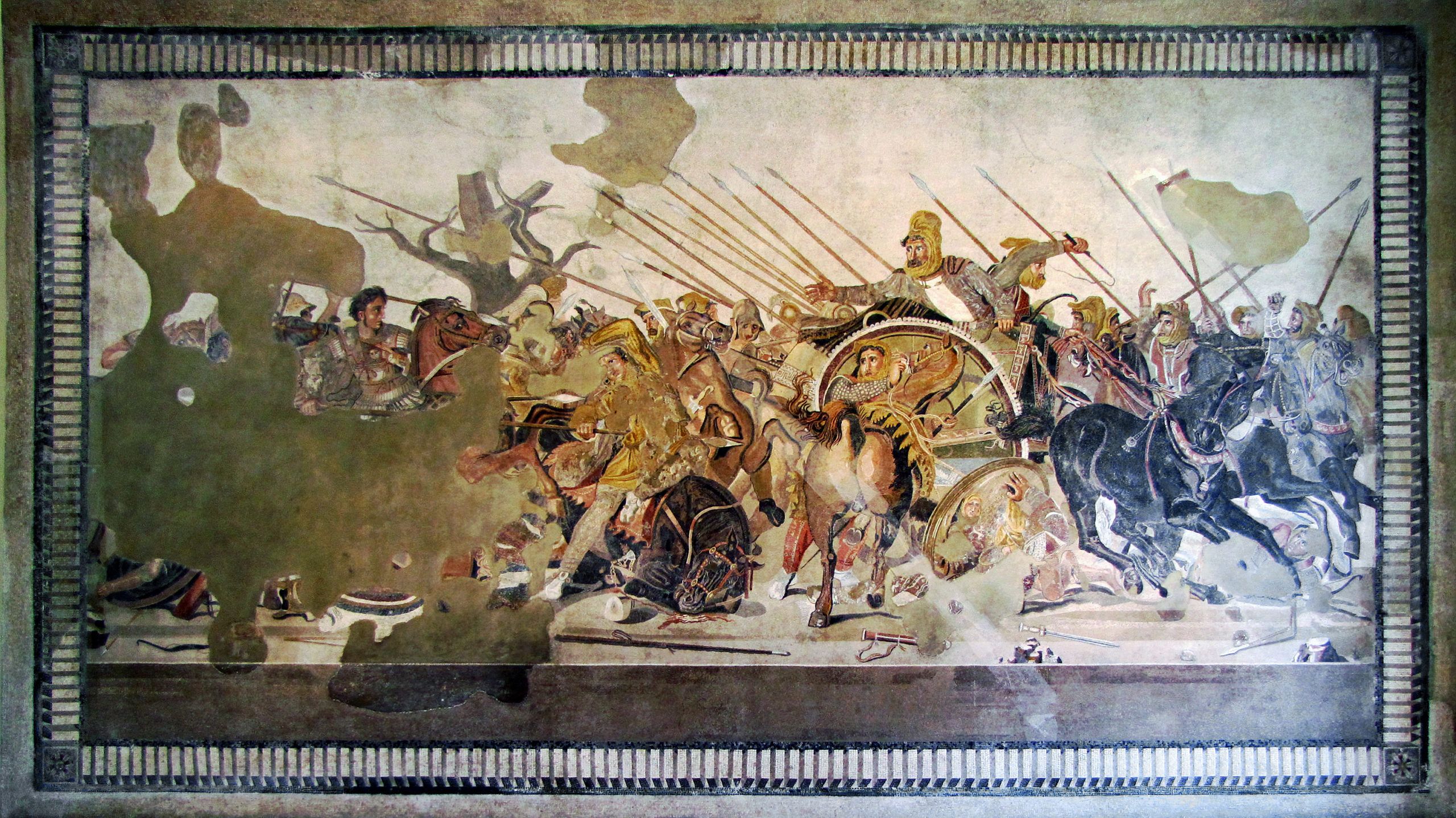
Alexander Mosaic, created in the 2nd century B.C.E., from the House of the Faun in Pompeii, reconstructed in the National Archaeological Museum, Naples
For example, the Alexander Mosaic from the House of the Faun in Pompeii was most likely based on a fourth-century Greek painting of a battle between Alexander and the Persian king Darius. Yet, the original subject was re-imagined as a tessellated mosaic that adorned the floor of a wealthy citizen in a small Italic town.

Athanadoros, Hagesandros, and Polydoros of Rhodes, Laocoön and his Sons, early first century C.E., marble, 7’10 1/2″ high (Vatican Museums; photo: Steven Zucker, CC BY-NC-SA 2.0)
Greek artists, trained in Greek sculptural schools, also moved to Italy to work directly for Roman patrons, creating new statues in the Hellenistic style for distinctly Roman contexts. One such group of artists was Hagesandros, Athenodoros, and Polydoros of Rhodes, who in the first century created the statue of Laocoön and sculpture for the emperor Tiberius for his grotto at Sperlonga. The Laocoön, like many other Hellenistic artworks, requires their audience to engage with the statue emotionally, feeling pity while watching the Trojan priest scream his agony while he is bitten by snakes and watches his sons die.
For all of these Greek artworks, copies, emulations, and original creations, found in Italy, it is vital to consider their Roman context as well as their Greek style or creation. These artworks were transformed by their new locations and audiences. A statue that originally served as a votive dedication in a Greek sanctuary took on a new meaning when it adorned the garden of a Roman villa.
In the conquered Greek territories, Hellenistic art and culture endured under Roman rule, yet in modified ways. For example, in western Anatolia, Greek was maintained as the dominant language, Greek gods were still worshiped, and art in the Hellenistic style was still produced. Yet, the stamp of Roman rule was visible everywhere, including in declarations of political loyalty that were inscribed in sanctuaries and public squares as well as the images of Roman emperors placed on the obverses of coins. These cities are emblematic of the hybridized nature of the Hellenistic world. They are politically part of Rome, culturally Greek, and ethnically Greek and Anatolian.
Watch videos and read essays about the rise of Rome
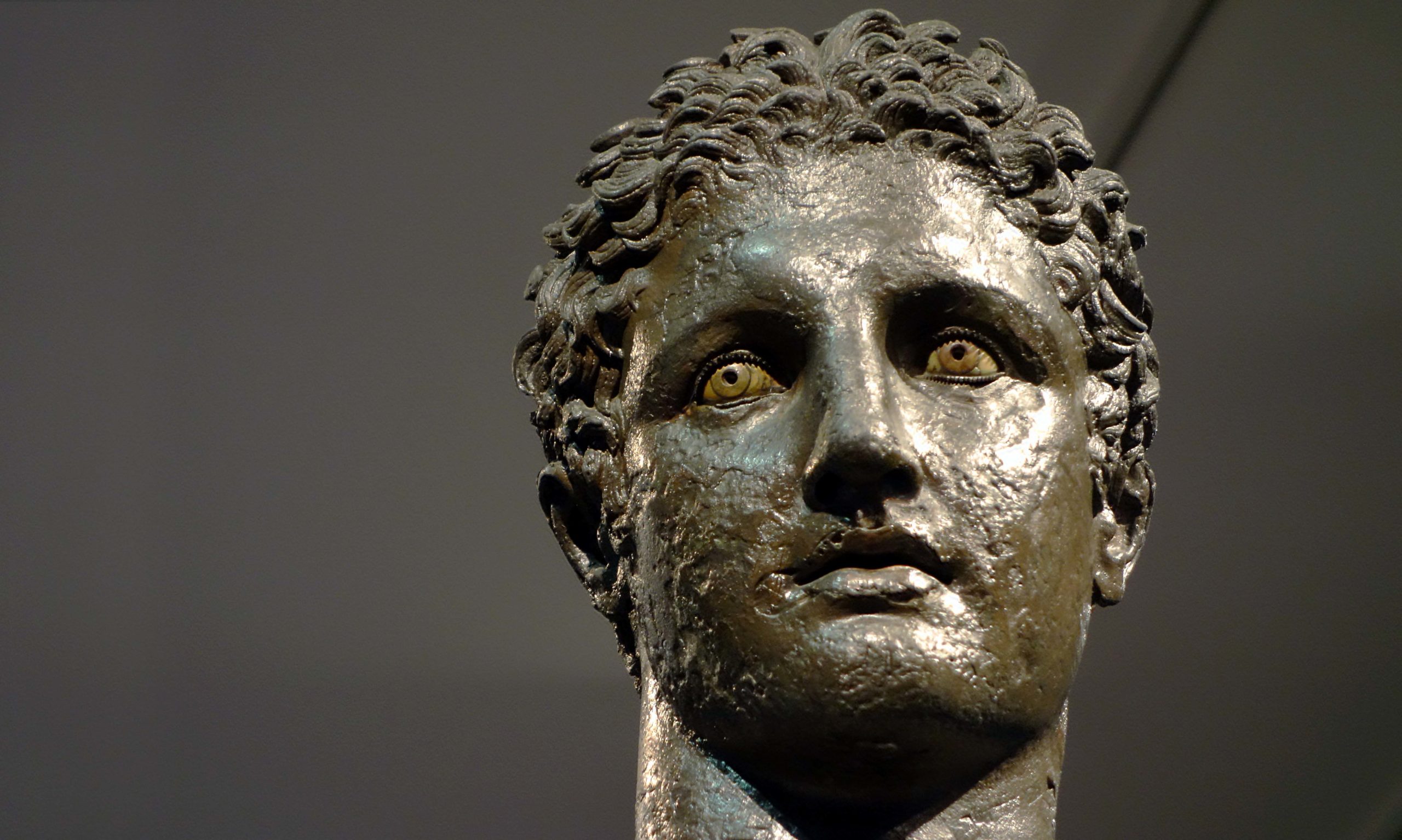
The Antikythera Shipwreck: Through exposure to the steady stream of loot into Rome as a result of military conquests, Roman elites had acquired a keen appetite for art and luxury goods produced in the Eastern Mediterranean—as this shipwreck helps us to understand.
Read Now >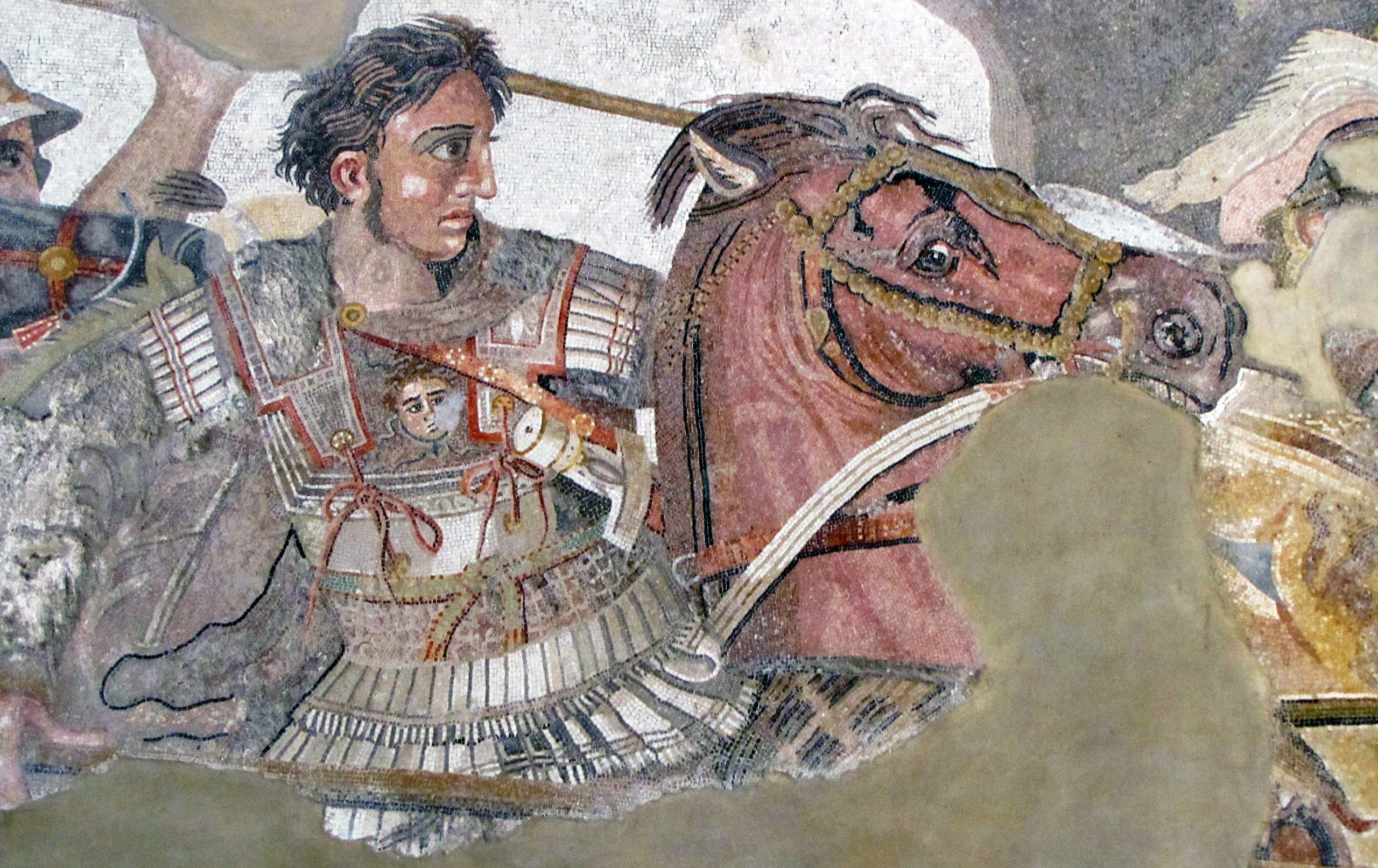
Alexander Mosaic from the House of the Faun, Pompeii: This stunningly detailed floor mosaic is usually believed to be a copy of an earlier Greek wall painting.
Read Now >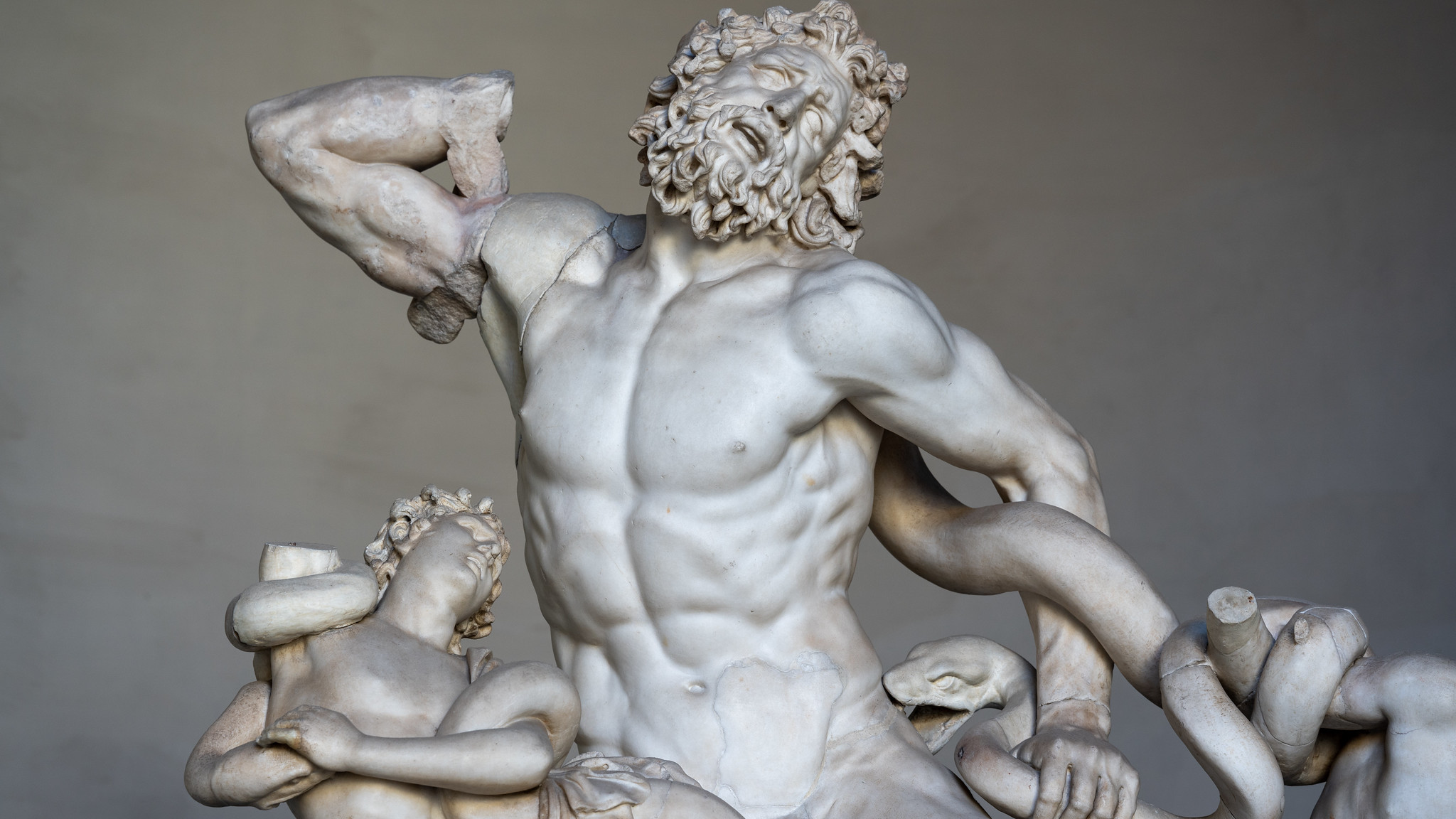
Athanadoros, Hagesandros, and Polydoros of Rhodes, Laocoön and his Sons: Most writers, however, argue that the Laocoön was made in Rome for Roman patrons.
Read Now >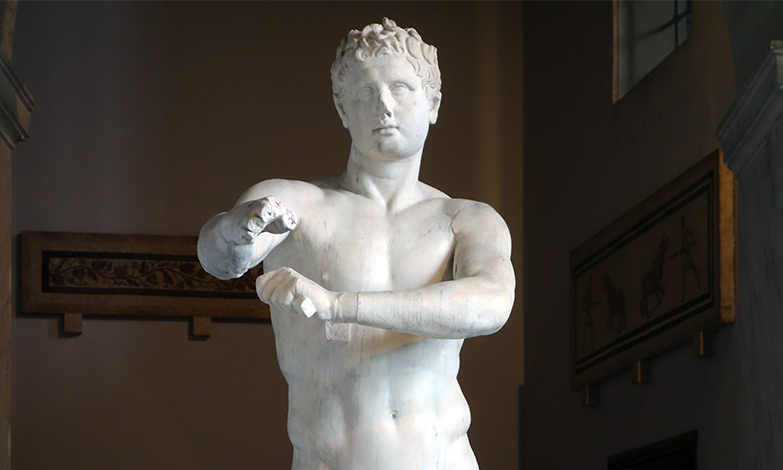
/4 Completed
The creation of new cultural, religious, and political identities, as well as new artistic forms to express these identities could be seen across the Hellenistic world. Art and architecture was produced by people of various ethnicities, languages, and religions who were conquered by Greek kings (and later Romans) and influenced by Greek cultural imperialism, yet also maintained aspects of their own native identities. This art is usually categorized as Greek, but it is much more than that, it is Hellenistic.
Key questions to guide your reading
Who was Alexander the Great? Why is his portraiture significant? What was the impact of the conquest of Alexander? How did these conquests lead to the creation of the Hellenistic empires?
What are the characteristics of Hellenistic sculpture? Considering issues such as cultural imperialism, displays of power, and changing identities, how do they reflect the period?
What buildings and sculptures were erected in the city of Pergamon in the Hellenistic period? How do these monuments reflect the political and cultural goals of the kingdom, its rulers, and its citizens?
How and why did Rome function as a center of Hellenistic art?
Jump down to Terms to KnowWho was Alexander the Great? Why is his portraiture significant? What was the impact of the conquest of Alexander? How did these conquests lead to the creation of the Hellenistic empires?
What are the characteristics of Hellenistic sculpture? Considering issues such as cultural imperialism, displays of power, and changing identities, how do they reflect the period?
What buildings and sculptures were erected in the city of Pergamon in the Hellenistic period? How do these monuments reflect the political and cultural goals of the kingdom, its rulers, and its citizens?
How and why did Rome function as a center of Hellenistic art?
Jump down to Terms to KnowTerms to know and use
Alexander the Great
Hellenistic kingdoms
High Relief
Macedonia
Mosaic
Pergamon
Sarcophagus

